Spring 2024 Course Guide
Welcome to the Spring 2024 Course Guide for the Department of Art and Art History!
We invite you to browse all the offerings and let us know if you have any questions. For individual courses, please reach out to the professor. For other questions about your major, minor, or our curriculum more generally, please contact your major advisor or any of us listed below. Department faculty and staff are happy to answer your questions and discuss your options by email or appointment.
Course Renumbering
Effective Fall 2023, all main campus courses have been renumbered using a new 4-digit numbering system.
- For Studio Art course equivalency, see here.
- For Art History course equivalency, see here.
- For Art & Museum Studies course equivalency, see here.
Department Contacts
Director of Undergraduate Studies in Art History – Prof. Ian Bourland
Director of Undergraduate Studies in Studio Art – Prof. Scott Hutchison
Director of MA Program in Art and Museum Studies – Prof. Lisa Strong
Department Chair — Prof. Elizabeth Prelinger
Department Coordinator – Em Aufuldish
Studio Art Courses
Drawing
ARTS 1100-01 – Drawing I

Perspective Drawing by Spencer Paik

Still Life Drawing by Leah Nishiguchi
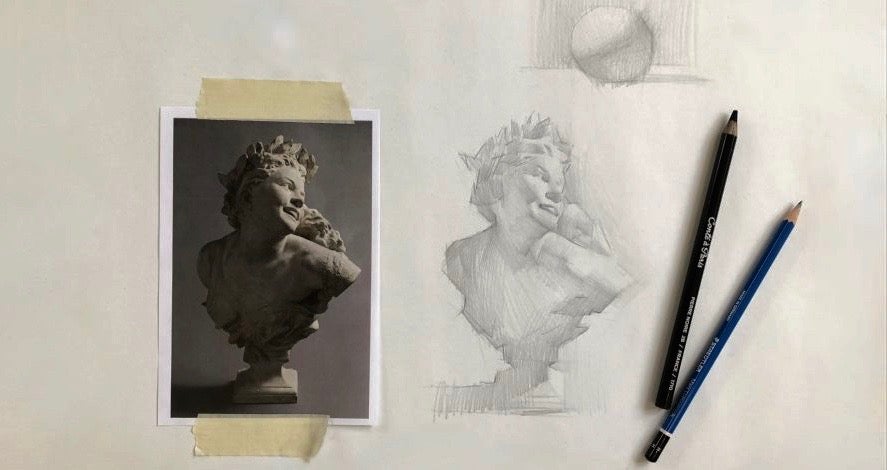
Demo by Marisa
ARTS 1100-01 – Drawing I This course will address the basic technical components of making a work of art through drawing. All levels of experience are welcome, and I will work with each student individually to ensure growth and improvement. We will begin the course working directly from still life and then move to more complex projects (figure, portrait) as the semester continues. Exploration, interpretation, and experimentation are encouraged! Students will build a drawing vocabulary and examine a variety of drawing philosophies that will transcend this course and assist them with the entire experience of making any type of art.
This course is taught by Professor Marisa Stratton.
ARTS 1100-02, -5 – Drawing I
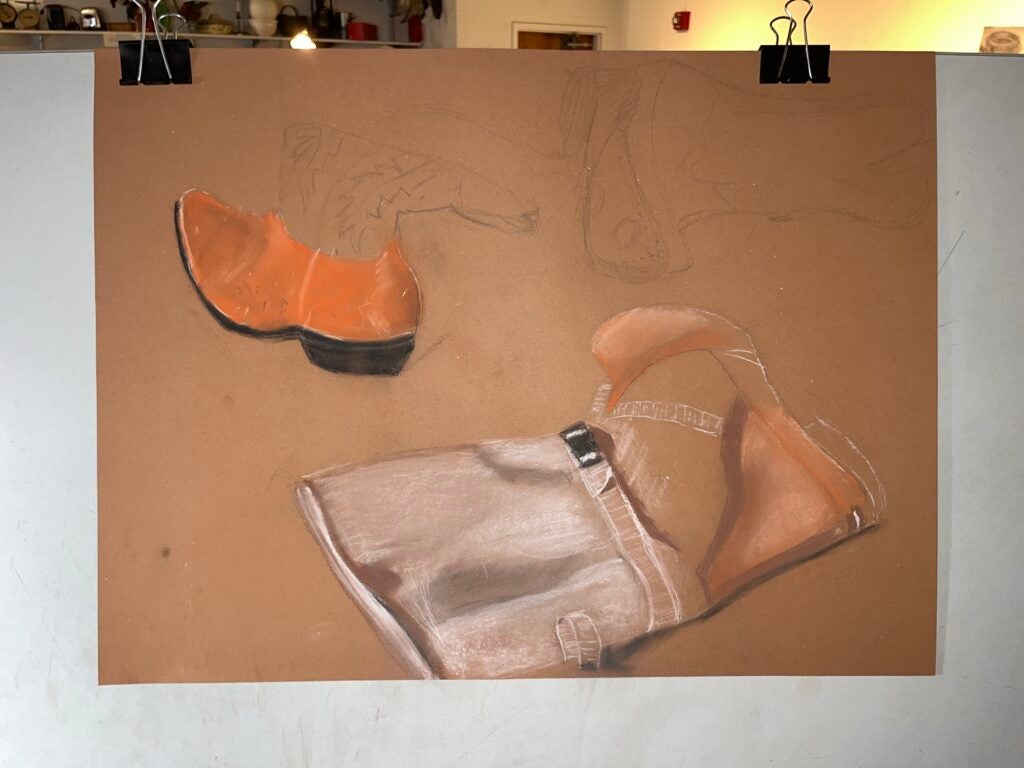
Barrett Hobbs, Drawing shoes on midtone paper
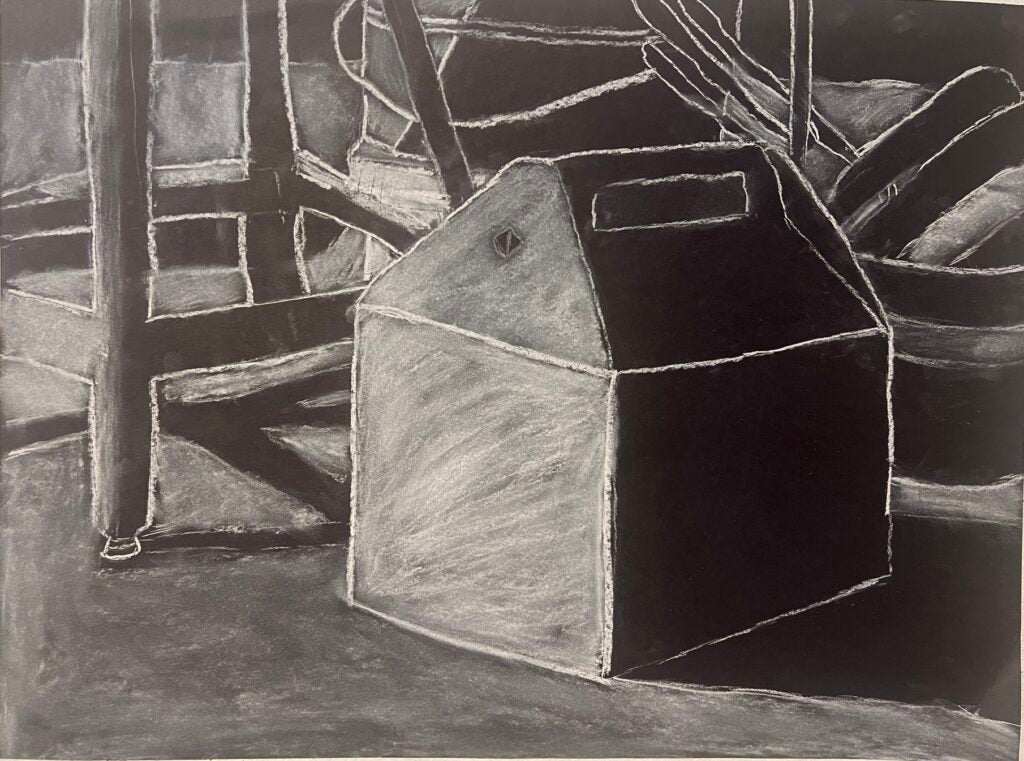
Tyler Fuller, Drawing on black paper
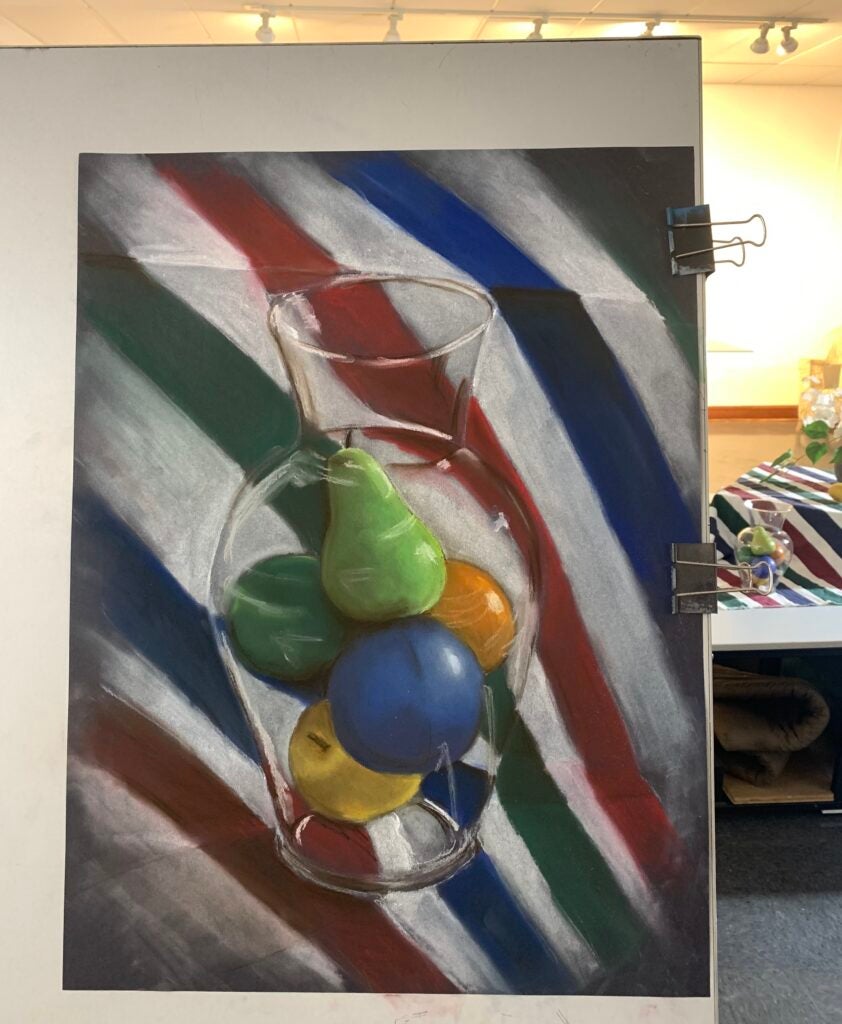
Elena Perez Alejandro, Color pastel on black paper
ARTS 1100-02, -05 – Drawing I This is a course on exploring the fundamental elements of art and the art making process using the medium of drawing. Emphasis is on creating an illusion of the three-dimensional world on a flat surface, your paper. Simple techniques that will enable anyone to draw from direct observation of the world around you will be introduced at the beginning of the course. The rest of the course will be dedicated to refining ways to see and finding means of expression. We will draw from still life objects, interior spaces and figure models. A variety of drawing materials including pencil, conté, charcoal, ink and color pastel will be explored. I will support everyone with their decision-making process of drawing. Learn to use formal art elements to build a drawing ultimately in your preferred style whether realistic or more abstract.
ARTS 1100 section -02 and -05 are taught by Professor Ji Yu.
ARTS 1100-04 – Drawing I
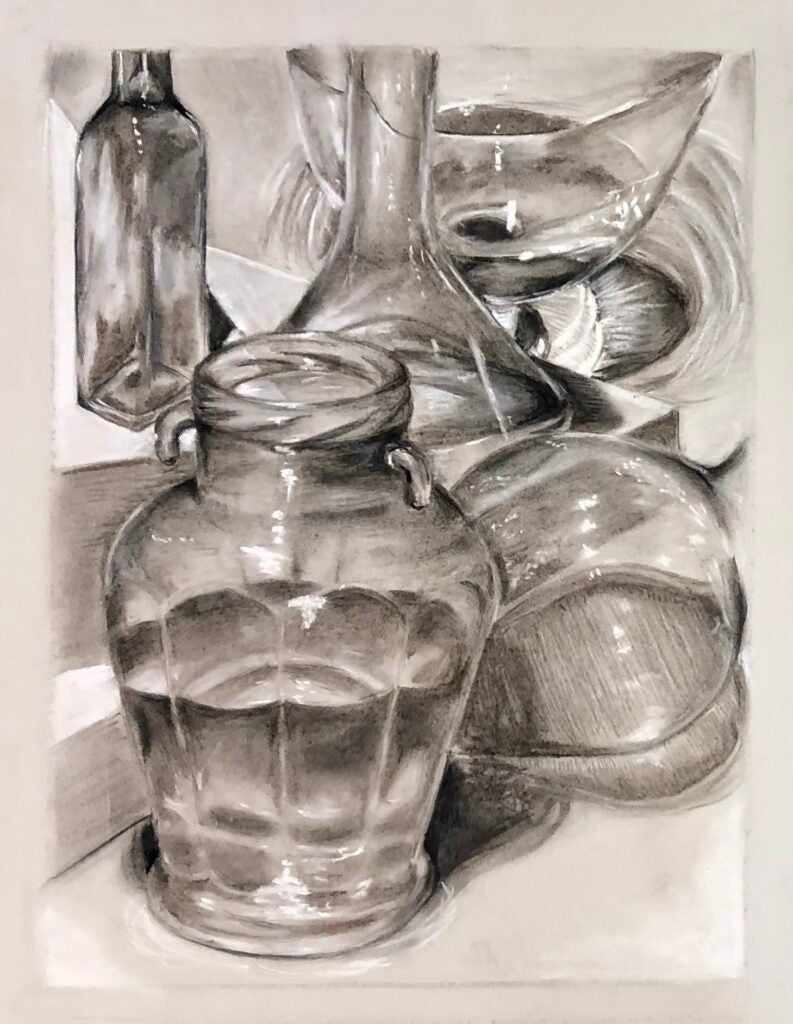
Jenna Royson, Reflections
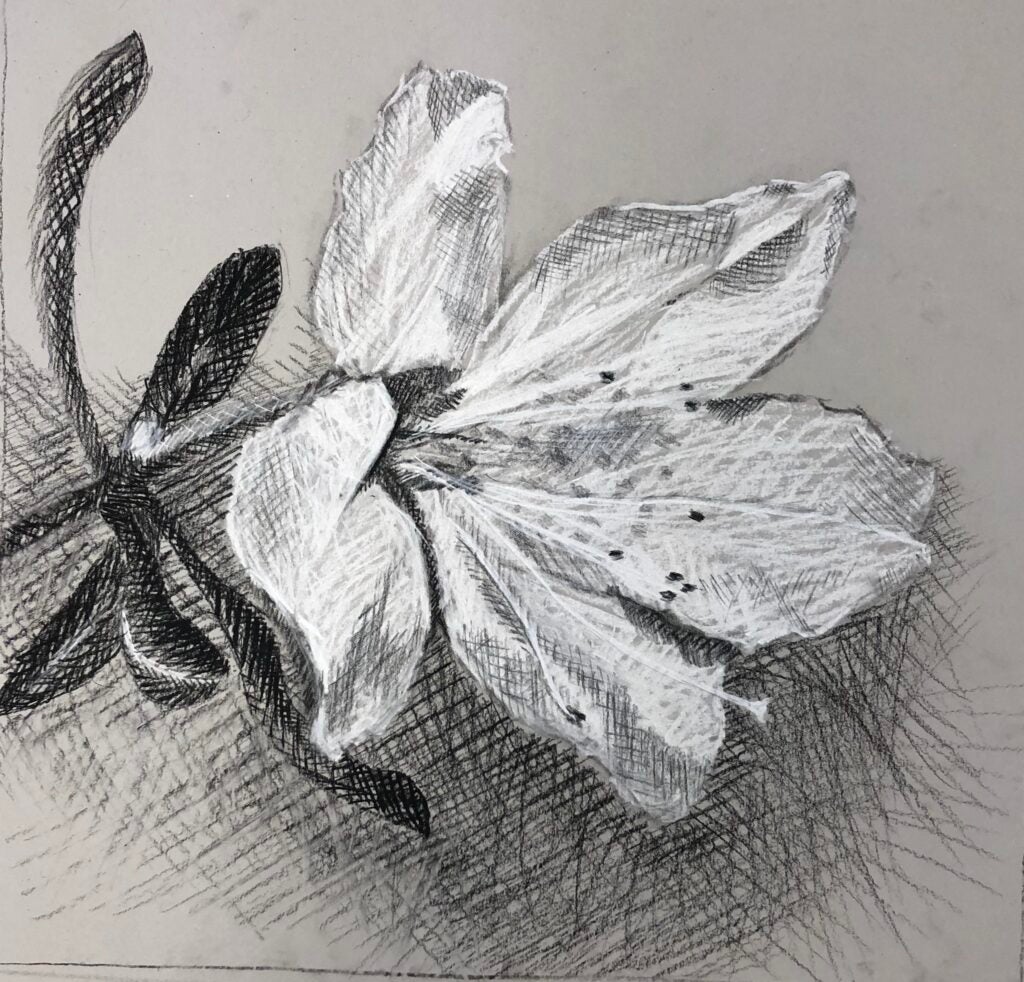
Kent Hall, Flower study
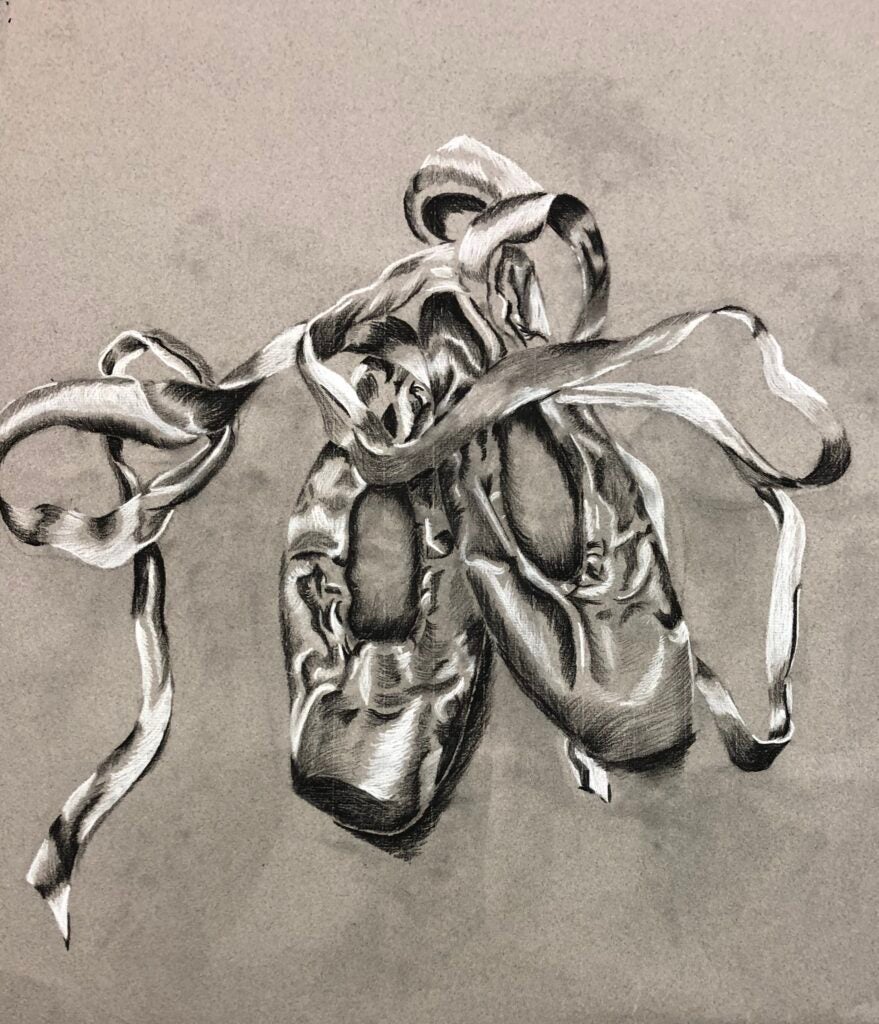
Jade Murphy, Ballet Slippers
ARTS 1100-04 – Drawing I In this course, students explore drawing as a graphic means to process the world around them. The class starts with the fundamentals of composition, and how to use light and shadow to describe form. We then look at line as a means of discovery and expression, along with other techniques of rendering form, space and texture. Projects range from still life and interiors to studies of nature, animal skulls and the portrait/figure. Students are approached on an individual basis as well as through group discussions, slideshows, demonstrations and critiques. “Learning to draw is really a matter of learning to see.” – Kimon Nicolaides.
This course is taught by Professor Ann Schlesinger.
ARTS 2100-01 — Drawing II: Figure
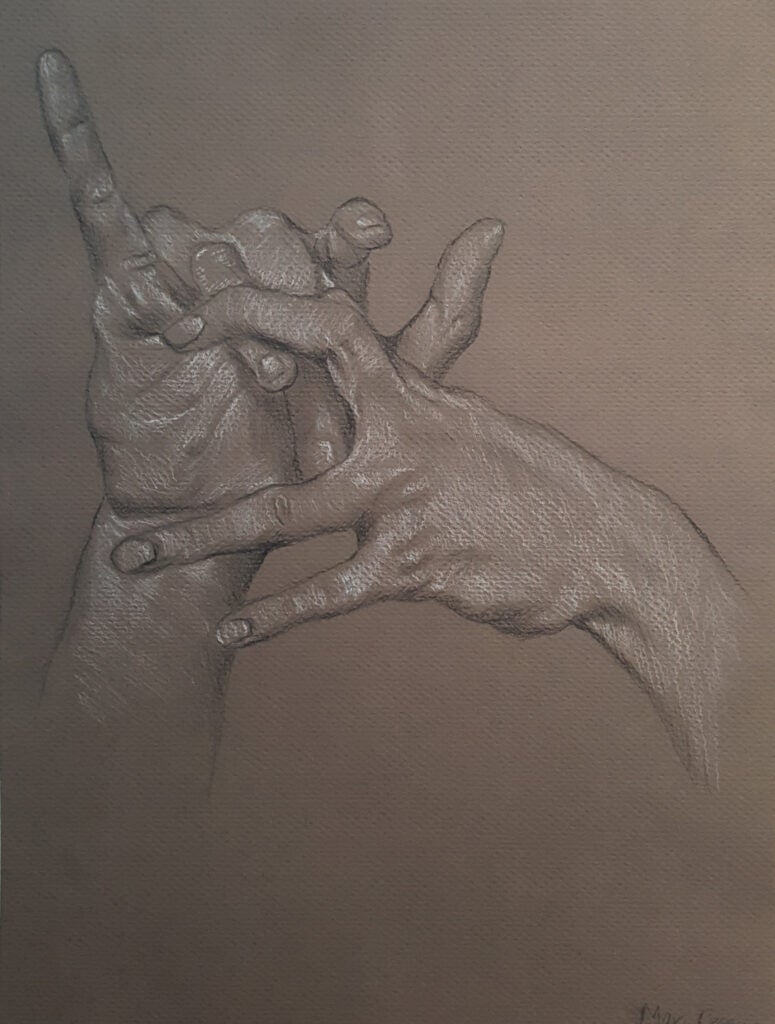
Student hand study
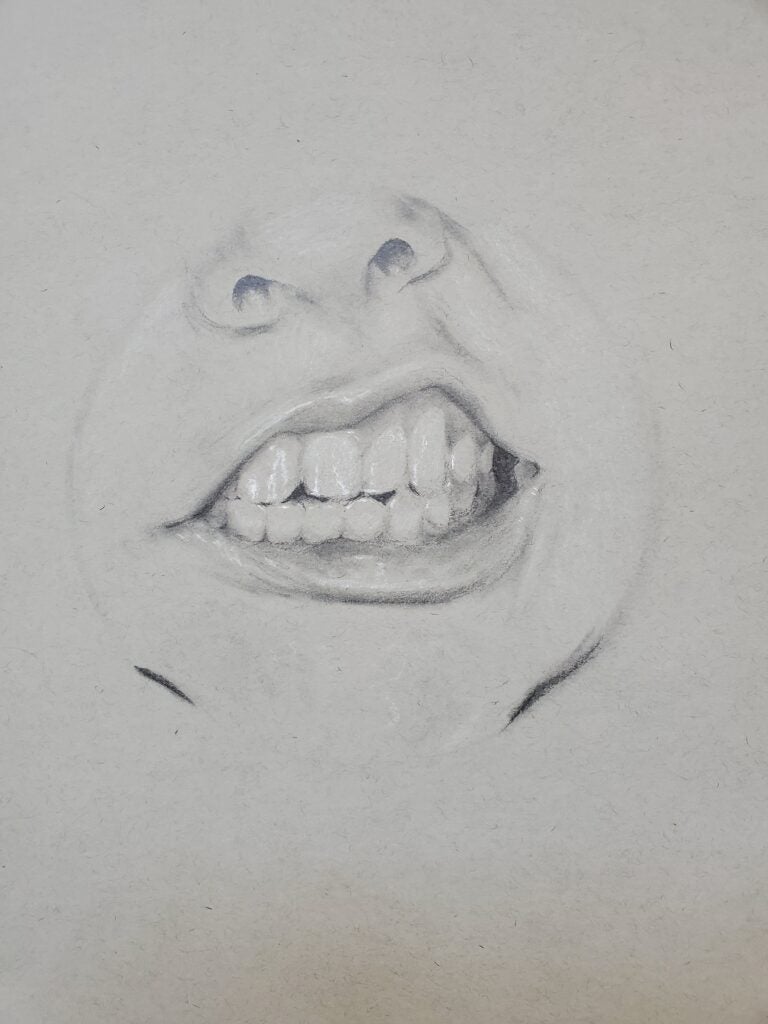
Student tooth study

Student old master copy
ARTS 2100-01 — Drawing II: Figure This painting course is focused on figurative drawing with the use of various media and techniques with the explicit aim to hone each student’s ability to render the human form with greater ease and accuracy. This class involves learning the complexities of life studies, drawing directly from a model for most class sessions. All formal and compositional concerns will be considered and are an essential aspect of the course. The students will be introduced to both traditional and contemporary figurative artists through lectures and museum visits and Old Master Copies. There is an emphasis on primarily traditional approaches to drawing to form a solid foundation upon which to build any further figure studies. As such, it is expected that the drawings made for this class aim to be in the realm of Realism. This course takes a more classical and comprehensive approach to drawing, starting with proportions and expressive line studies and culminating in the trois crayon technique and the like. The goals of the course are to teach classic techniques of figurative drawing in incremental steps that will allow students to build confidence in their work. Students will gain from their observation and consistent life renderings, a better ability to map and execute whatever they desire.
This course is taught by Professor Erik Sandberg.
ARTS 2105-01 — Drawing II: Themes & Explorations

Kent Hall, Self-portrait
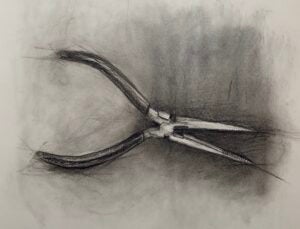
Reagan Graney, Needlenose pliers
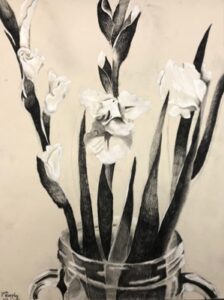
Jade Murphy, Flower study
ARTS 2105-01 — Drawing II: Themes & Explorations In this course, students explore the unique way that drawing as a discipline lets them investigate and interpret the world around them, as well as further develop their ideas of visual language and expression. Students focus on three to four themes of personal interest, with the goal of creating a portfolio in which a variety of drawing approaches and concepts are explored in depth. Possible themes could include: portrait/ self-portrait; forms of the natural world (plants, roots, skulls); personal objects that convey character; landscape, architecture or figures within a space; texture, surface and/or space as an expressive tool, etc. The course is highly individualized, adjusted to each student’s interests and goals, and its main emphasis will be for students to experiment with and push visual ideas and concepts in drawing.
This course is taught by Professor Ann Schlesinger.
Printmaking
ARTS 1201-01 – Printmaking I: Intaglio
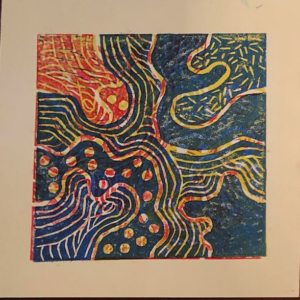
Grace Nguyen
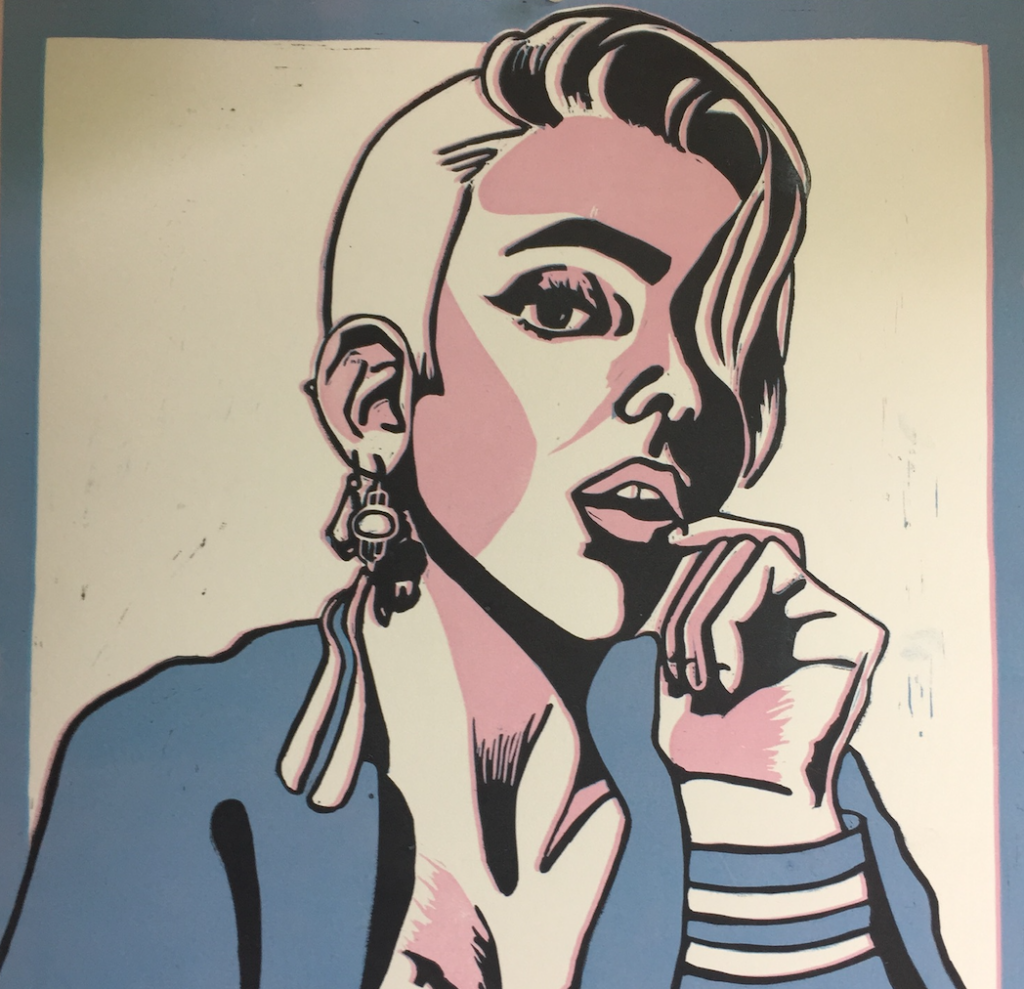
Tyler McConville

Grace Nguyen
ARTS 1201-01 – Printmaking I: Intaglio This course utilizes traditional hand printing of relief images from Linoleum plates. Test plates are done in color and in balc and white. Folds and simple bookmaking are presented as options. After learning safe cutting, registration and printing methods, students are encouraged to pursue their own personal imagery. Critiques and view and response of videos and online print-related sites is required.
This course is taught by Professor Scip Barnhart.
ARTS 1603-01 — Art of the Book

Olivia Tatarian
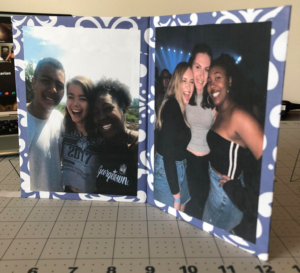
Jordyn Jones
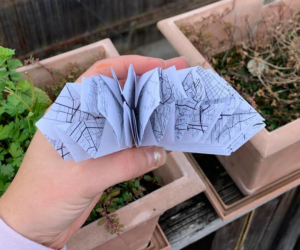
Olivia Tatarian
ARTS 1603-01 — Art of the Book This course explores the practice and creation of unique artist books. Multiple bindings, sewing, folds, cutting methods, and techniques are taught to prepare students for personal expression through handmade books.
This course is taught by Professor Scip Barnhart.
Photography
Digital
ARTS 1301-01 – Photo I: Digital

Natalie Sanders, Long Depth of Field

Valerie Sanchez, Summer 2020
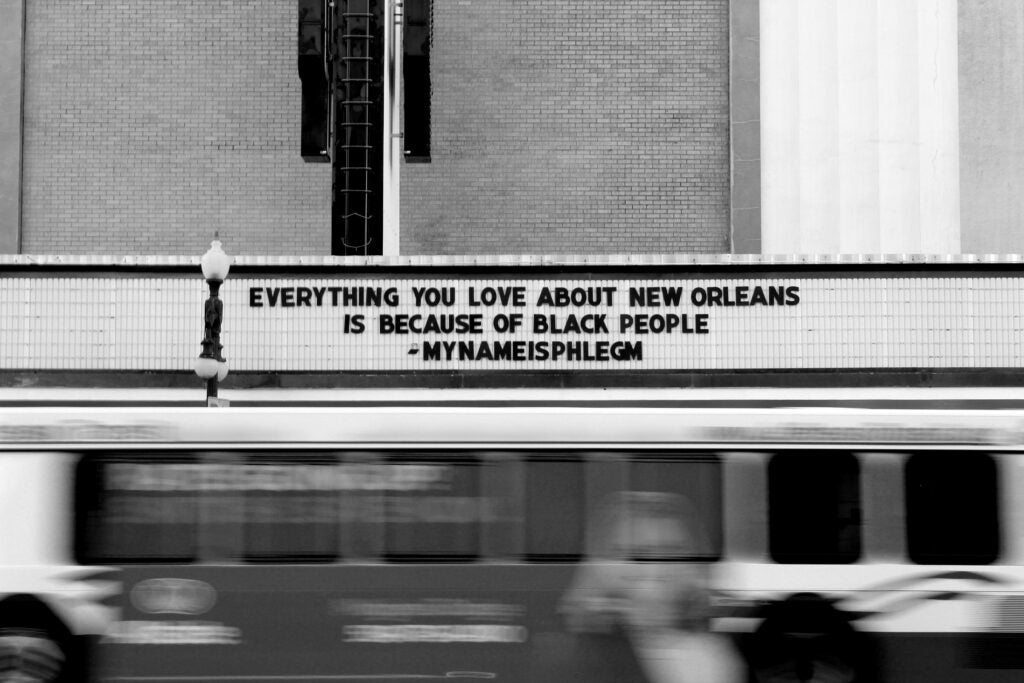
Leo Arnett, Summer 2020
ARTS 1301-01 – Photo I: Digital This is a basic digital photography studio art course designed to develop the hands-on skills necessary to produce and identify the elements of a good photograph and to acquire a thorough working knowledge of digital equipment. Students will gain an understanding of the aesthetic and technical areas of photography as a fine art. Class lectures, discussions and digital assignments will deal with photographic composition, criticism and history. Fundamental knowledge of computer programs such as Photoshop will be introduced in the semester to develop photographic imagery.
This course is taught by Professor Kelly Carr.
ARTS 1301-02 – Photo I: Digital
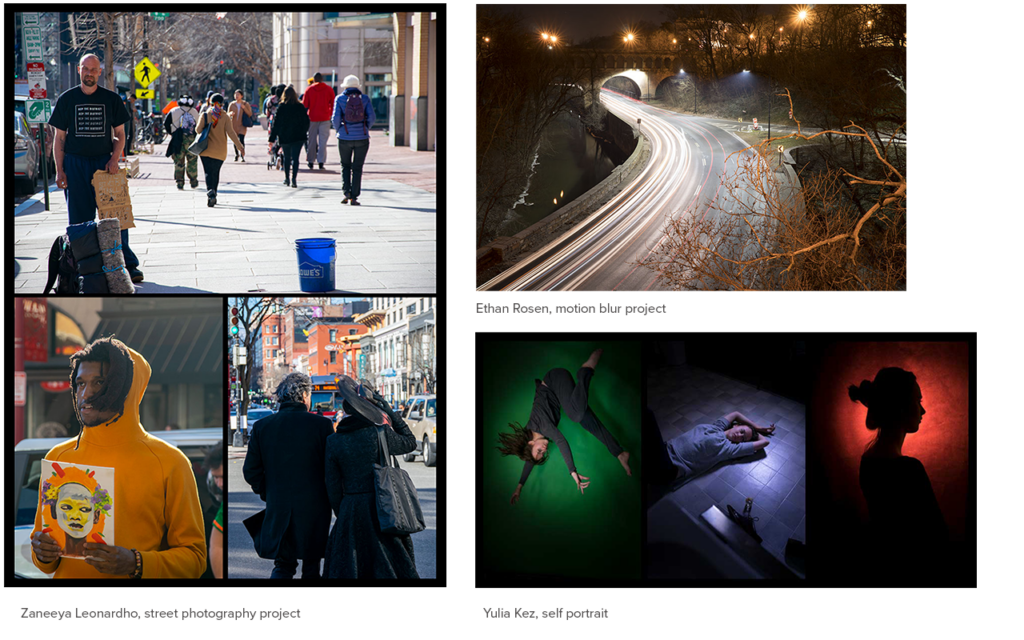
ARTS-1301-02 — Photo I: Digital This is an introductory digital photography studio art course designed to develop the hands-on skills necessary to produce and identify the elements of a good photograph and to acquire a thorough working knowledge of digital equipment. Students will gain an understanding of the aesthetic and technical areas of photography as a fine art. Class lectures, discussions and digital lab assignments will deal with photographic composition, criticism and history, camera and paper types, and printer systems. Fundamental knowledge of computer programs such as Photoshop will be covered for students to edit and print their work. Students enrolled in studio courses must devote a minimum of 4 to 6 hours per week outside of class to develop and complete assignments. Through the analysis of the history of this medium this class involves the study of photography as a metaphor for the human condition with students engaging in self-reflection and questioning through analysis, inquiry, dialogue and creation.
This course is taught by Professor Roberto Bocci.
ARTS 1302-01 — Photo I: Alternative Processes
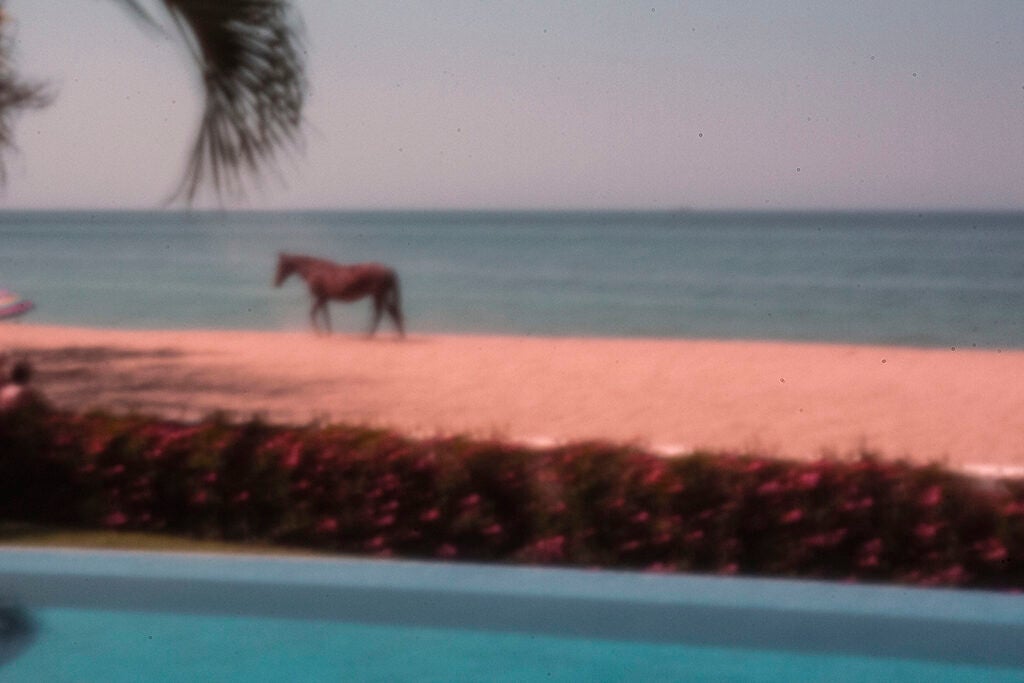
Ashley Mayhall, DSLR Pinhole Camera

Jingyi Tang; Cyanotype
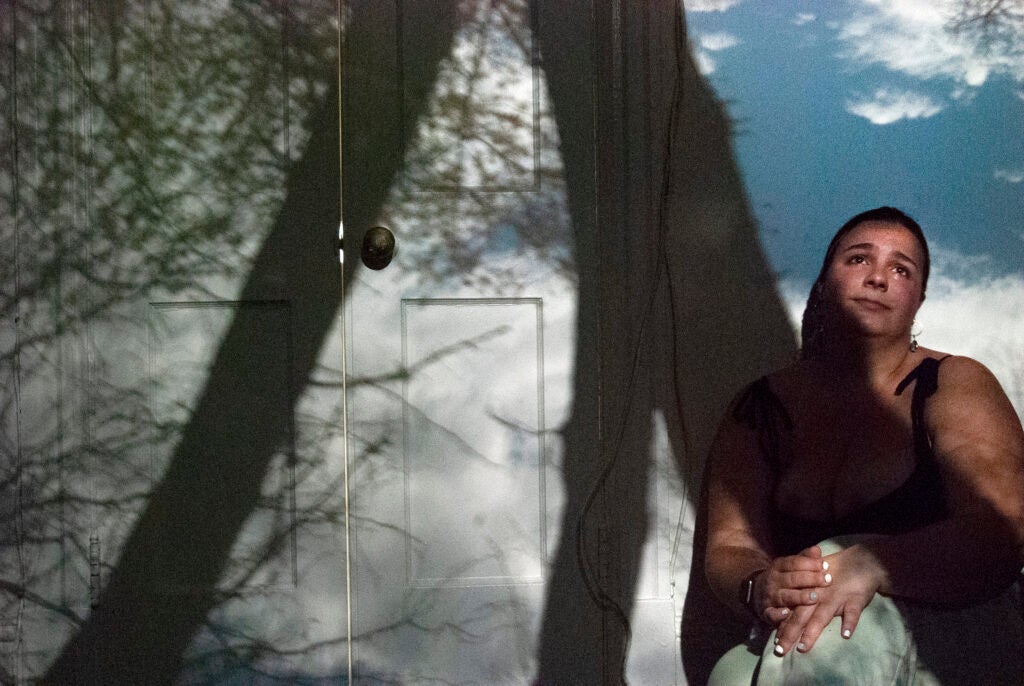
Katie Watke; Camera Obscura
ARTS 1302-01 — Photo I: Alternative Processes Back in the day meets modern day, contemporary alternative photographic processes. This class combines modern day technology with historic non-traditional printing and photographic processes. DSLR cameras and photo editing software are applied to centuries old photographic processes. Students will gain knowledge of both digital and hands-on non-traditional processes. Additionally, the class will include discussions as to history, invention, and contemporary artist regarding each process.
This course is taught by Professor Kelly Carr.
ARTS 2300-01 – Photo II
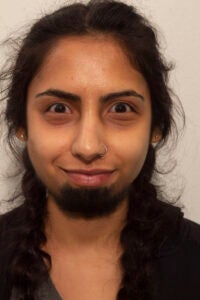
Pedro Ramirez, Nancy Burson project
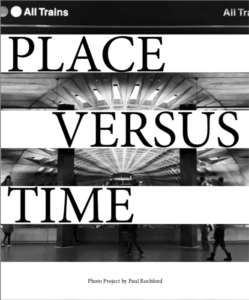
Paul Rockford, Booklet Project

Henry Smithers, Text-to-Image project
ARTS 2300-01 – Photo II is an advanced class for both film and digital photography students to continue shooting and printing their creative work in order to compile a portfolio that can be used to apply for internships, jobs or graduate school. Projects include the portrayal of a city (Washington DC and/or other), event documentation (the documentation of street events, political protests, rock concerts etc.), a book-making project that can be printed and bound in-house or sent out to companies like Blurb, and mini projects to learn how to use advanced Photoshop compositing and editing techniques. Projects can be developed on film or digital format and printed as gelatin silver and/or digital prints. As students produce work the prints are inserted into a hard copy portfolio or added to a website. The primary software packages you will use are Adobe Photoshop and Bridge and/or Adobe Lightroom.
This course is taught by Professor Roberto Bocci.
Sculpture
ARTS 1400-01 & 1400-02 – Sculpture I
There are two sections of 1400, at different times.
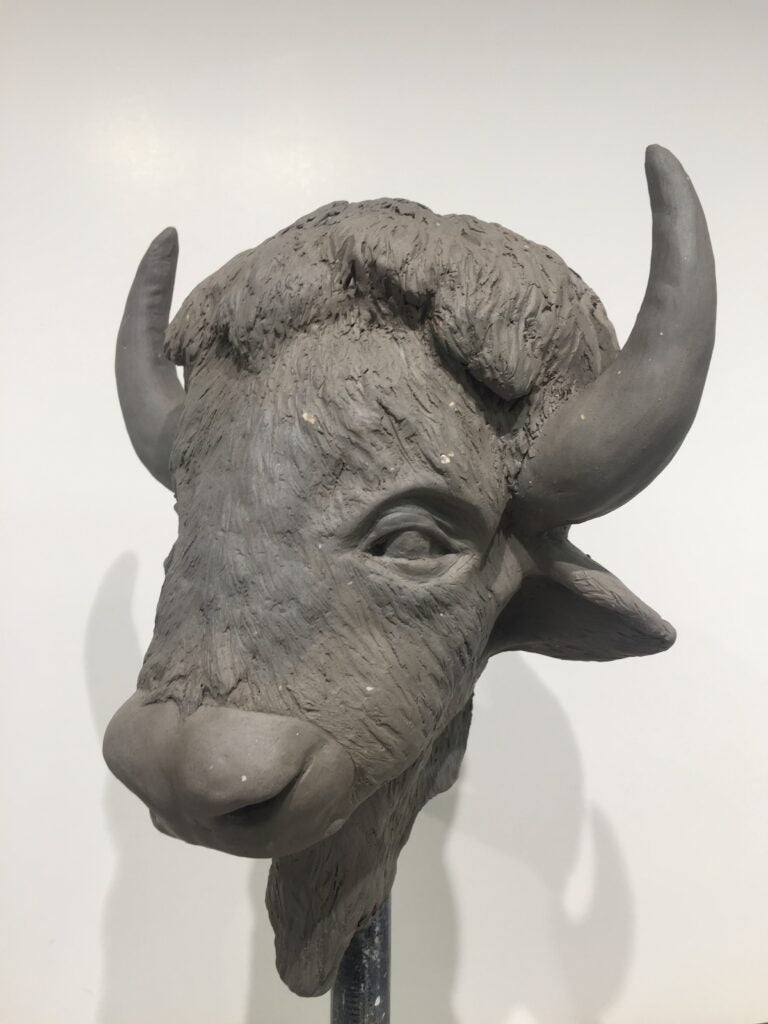
Sidney Lee, Modeling from life

Sean Letendre, Cardboard self-portrait

Corine Forward, Spring 2019, Micro Monument Assignment
ARTS 1400-01 & 1400-02 Sculpture I offers students the opportunity to exercise their creative drive through making three-dimensional form. Students work in traditional and contemporary methods and materials. During the semester there are three thematically driven projects that simultaneously introduce new materials, processes, and conceptual consideration. The semester will include projects that range from modeling a form in clay, creating sculptures with recycled cardboard, and using found objects to construct a sculpture. This course is designed for the novice sculptor and assignments emphasize foundational skills.
Please note that the Sculpture Studio is located in the basement of the Walsh building, down one flight of stairs. This room is not wheelchair accessible.
These courses are taught by Professor Evan Reed.
Painting
ARTS 1500-01 – Painting I: Oil

Still Life by Allie Stevens
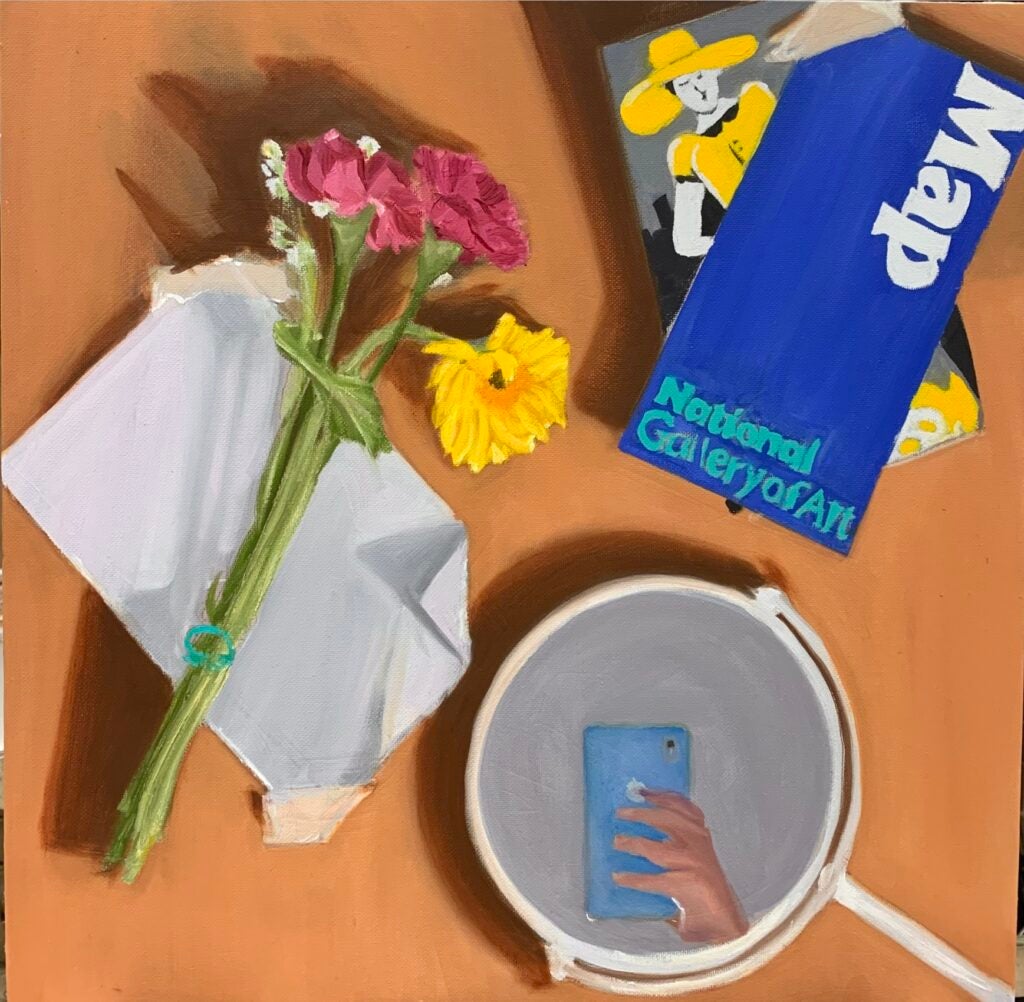
Trompe L’oeil Still Life by Nicole Keller

Trompe L’oeil Still Life by Kayla Zamanian
ARTS 1500-01 — Painting I: Oil This course will address the basic components of making a work of art through oil painting. All levels of experience are welcome, and I will work with each student individually to ensure growth and improvement. We will begin the course working directly from still life and then move to more complex projects as the semester continues. The course will provide historical context for traditional methods of oil painting, as well as contemporary modes of making. Exploration, interpretation, and experimentation are encouraged! Students will build a painting vocabulary and examine a variety of painting philosophies/methods that will transcend this course and assist them with the entire experience of making any type of art.
This course is taught by Professor Marisa Stratton.
ARTS 1500-02 – Painting I: Oil

Zoom Black and White Demonstration
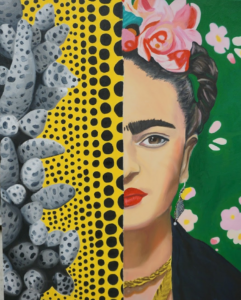
Melissa Gonzalez, Collage Painting Project

Susanna Hermann, Multiplicity Painting Project
ARTS 1500-02 – Painting I: Oil This is an introductory painting course that teaches the basic techniques of painting. Students learn to paint from observation, in a manner that results in a realistic depiction of the subject. However, the goal of this course is not to make copies, but to strike a balance between an art historical approach to painting with a contemporary one – fostering an environment that encourages students to think creatively and to experiment with the paint and the subject. This is achieved through live demonstrations, artist slide lectures, group, and individual critiques.
This course is taught by Professor Scott Hutchison.
ARTS 1500-03 – Painting I: Oil
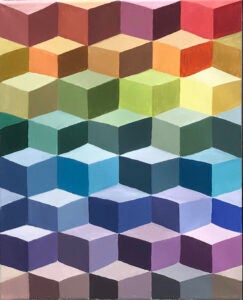
Julia Tolfa.
Oil on canvas.
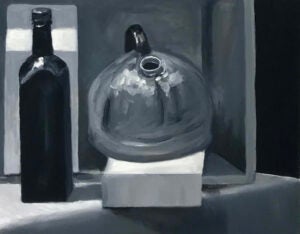
Ethan Clark
Oil on canvas.
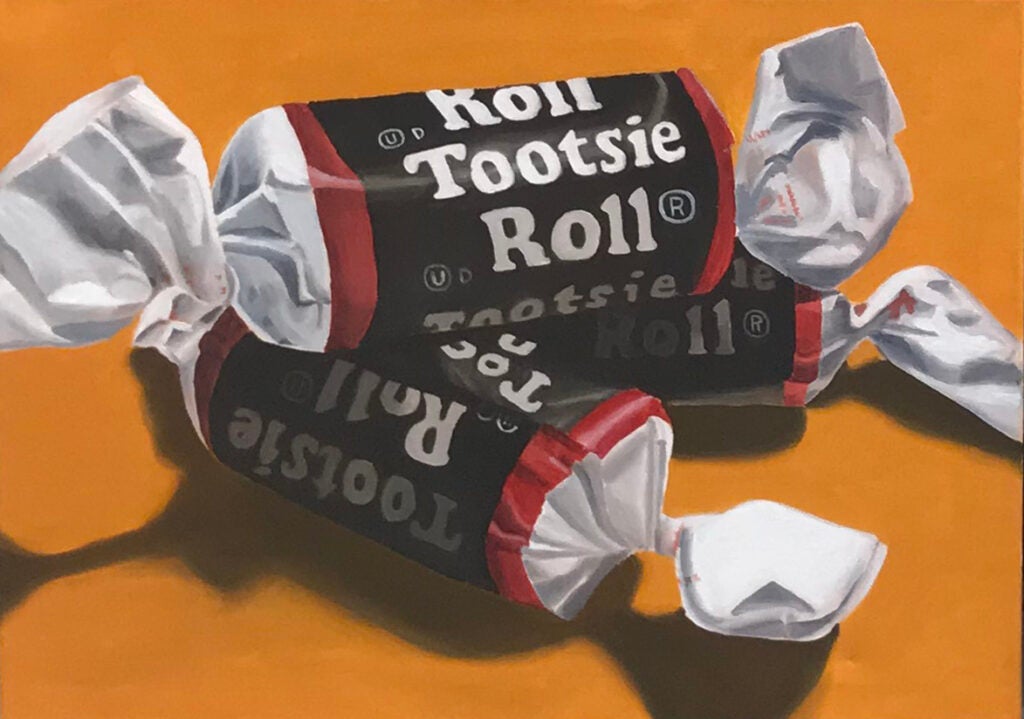
Julia Tolfa.
Oil on canvas.
ARTS 1500-03 – Painting I: Oil, is a studio art class developing the techniques and concepts of painting in traditional, oil medium used from the Renaissance to today. Students will learn the basic techniques of transparent glazing and opaque oil painting. They will investigate the impact of color and value on the illusion of space and form. While focusing on the traditional subjects of landscape, still life, and figure, they will create a portfolio of three paintings developing their drawing and painting abilities with the medium. Studio demonstrations, lectures, slide presentations and individual and class critiques will be conducted online using Zoom and Canvas to present all aspects of instruction. Students create oil paintings during regular class sessions with feedback from the instructor. They continue to develop their paintings outside of class. The students receive individual guidance and evaluations from the instructor during each class as well as valuable insights from the student discussions during class critiques.
This course is taught by Professor John Morrell.
ARTS 1501-01 – Painting I: Acrylic
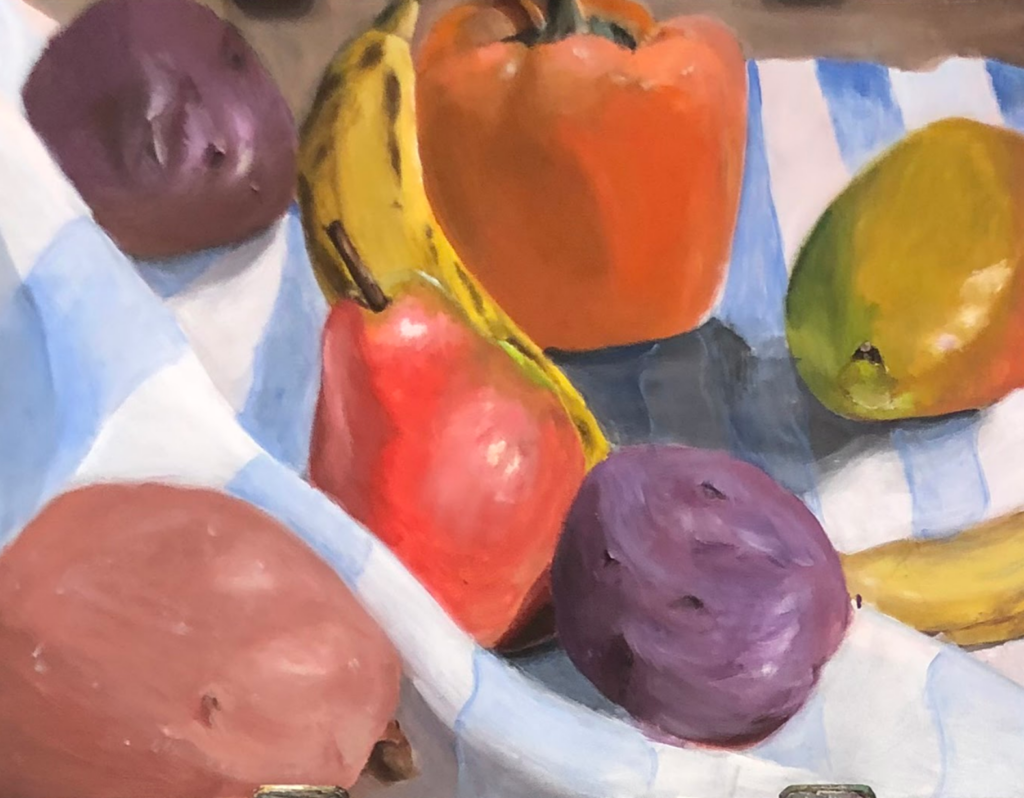
Project 3: Fruit with multiple colors
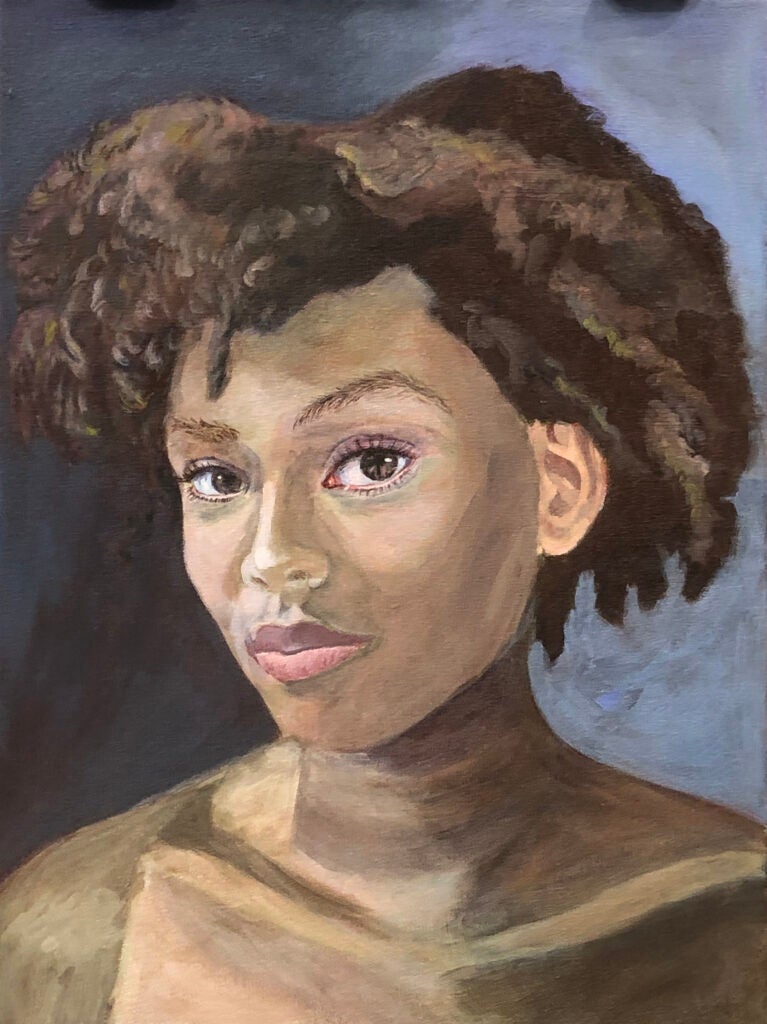
Allemai Dagnatgchew, Project 4: Self-portrait

Cristina Macaya, Fragmented Self
ARTS 1501-01 – Painting I: Acrylic This is an introductory course that consists of lectures and studio labs. This course focuses on both the acquisition of fundamental knowledge of acrylic painting, and the creation of paintings using one’s own unique imagery. Relevant art historical references and resources will be introduced in order for students to contextualize their work in reference to art history. Students will utilize critical thinking and problem-solving skills by doing progressively challenging assignments. As they work on these assignments throughout the semester, they will develop a more sophisticated aesthetic approach in the areas of color, composition, perspective, balance, and subject matter. There will be five class critiques (four critiques for each individual assignment and the last final critique for the entire course) throughout the semester and each student will have opportunities to discuss their work as well as the work of others.
This course is taught by Professor BG Muhn.
ARTS 1502-01 – Painting I: Watercolor
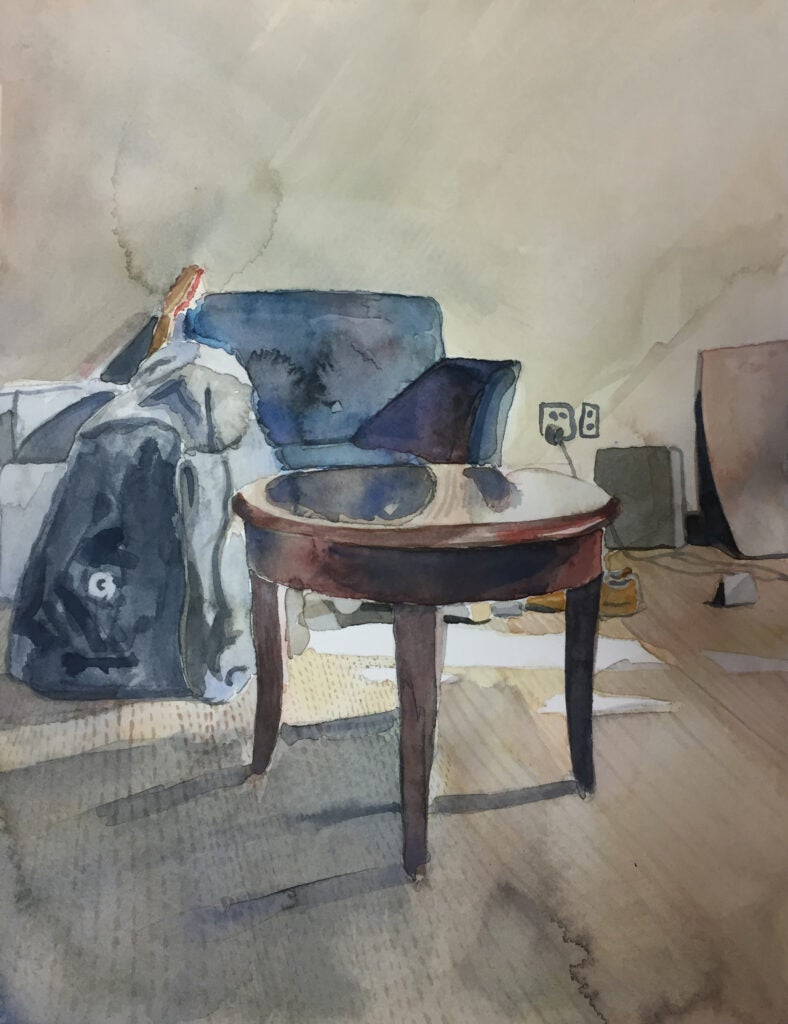
Edson Martinez.
Watercolor on paper.

Danielle Deiotte.
Watercolor on paper.

Jack Wathieu.
Watercolor on paper.
ARTS 1502-01 — Painting I: WatercolorThis is a studio art class focused on developing the techniques and concepts of painting in traditional, water-based medium. Students will learn the basic techniques of transparent and opaque watercolor. They will investigate the impact of color and value on the illusion of space and form. While focusing on the traditional subjects of landscape, still life, and figure, they will create a portfolio of five images developing their drawing and painting abilities with the medium. Studio projects (watercolors), demonstrations, lectures, and; individual and class critiques will be conducted online using Zoom and Canvas to present all aspects of instruction — technique demonstrations, slide presentations and class discussion. Students create watercolors during regular class sessions for one-on-one feedback from the instructor and they continue to develop their paintings outside of class. The students receive individual guidance and evaluations from the instructor during each class as well as valuable insights from the student discussions during class critiques.
This course is taught by Professor John Morrell.
ARTS 2500-01 — Painting Studio II
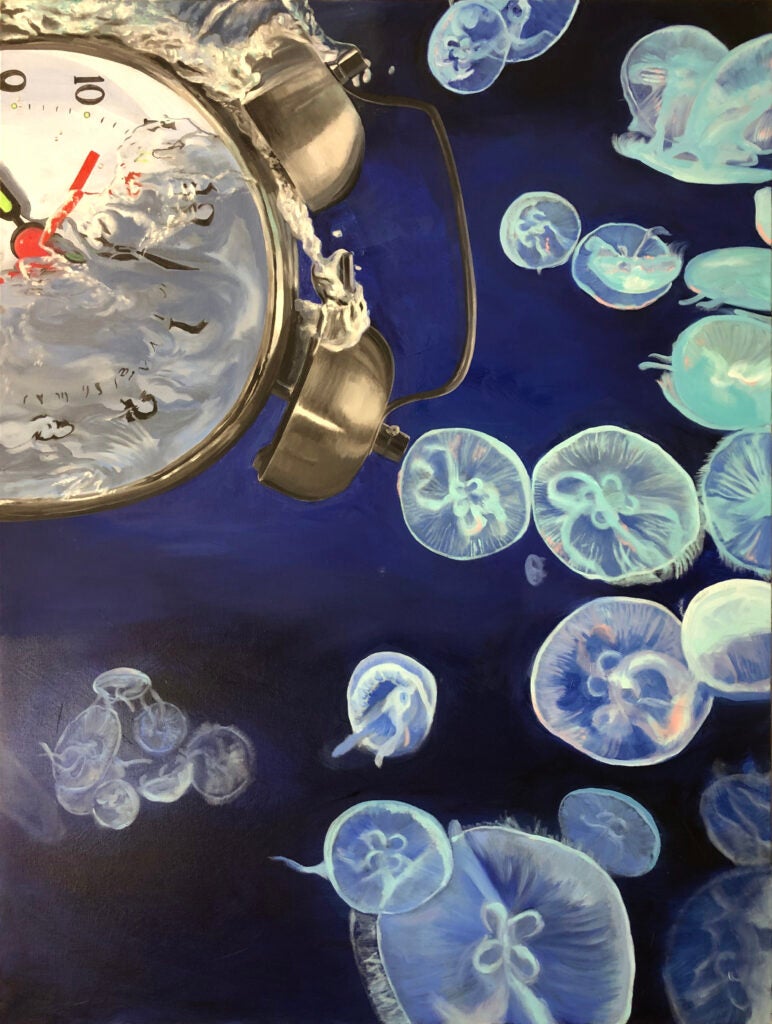
Jude An, Project 1: Conceptual Container
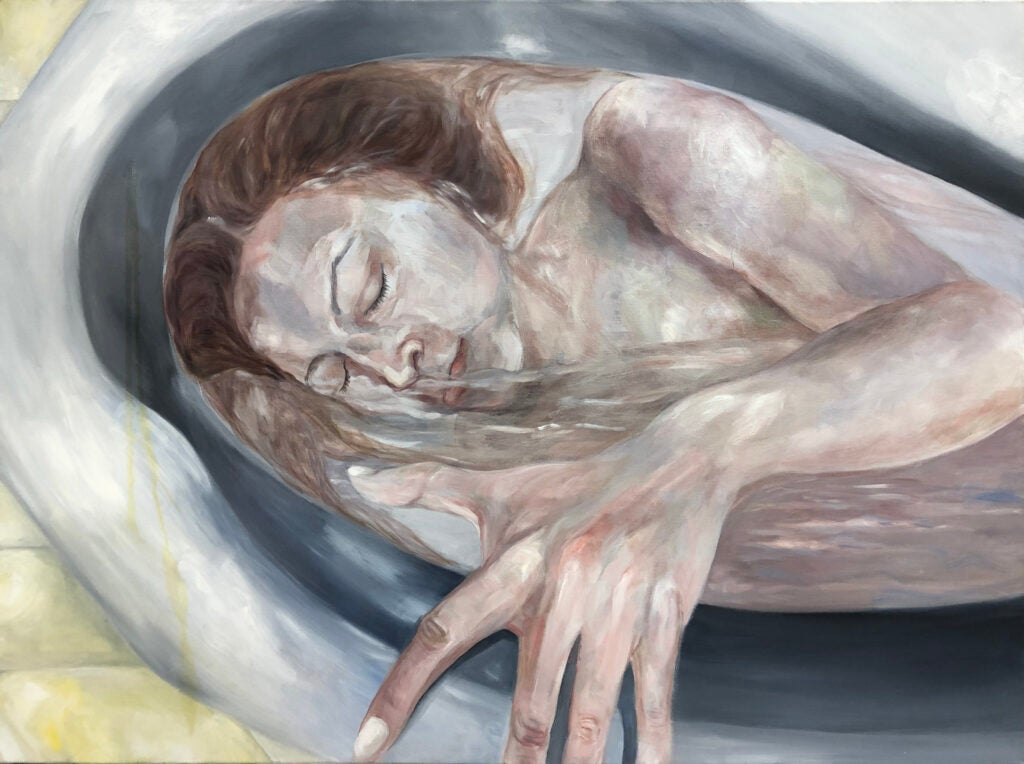
Christina Shoucair, Project 1: Conceptual Container
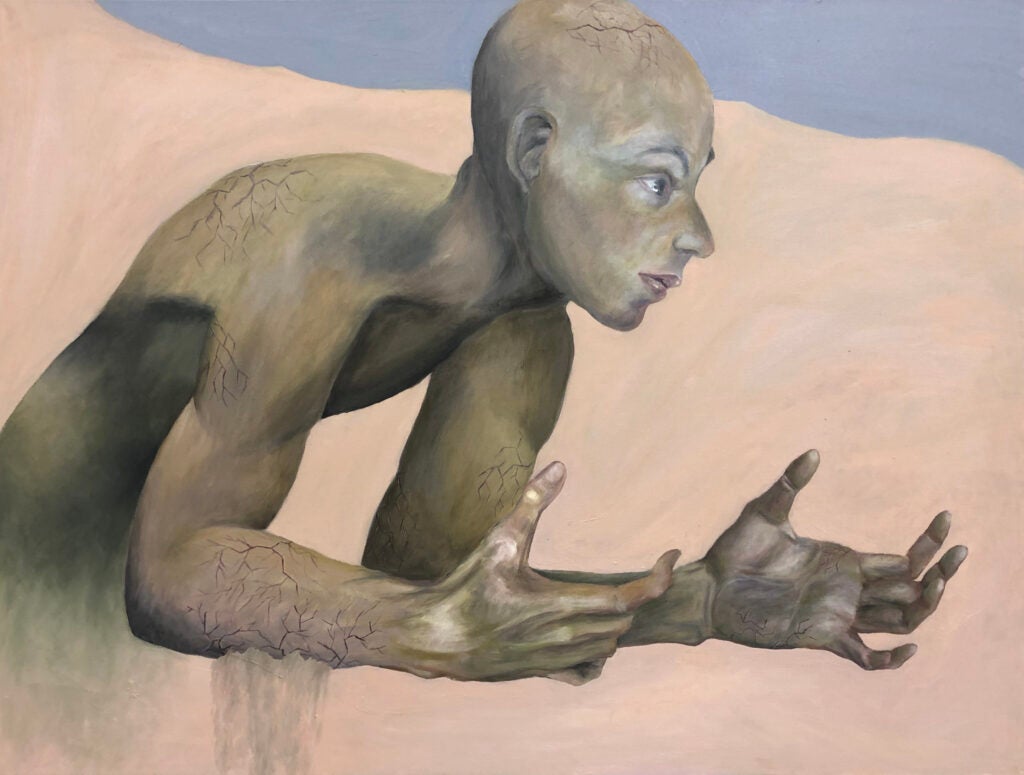
Sharon Huynh, Project 2: Human Body
ARTS 2500-01 — Painting Studio II This is an intermediate-level painting course. The overall theme of the assignments for the semester is moving away from straight observational painting and exploring imagination and visual dynamism within a juxtaposition of the real and the unreal, blurring the boundaries between dream and reality and consciousness and the subconscious. This will be the overarching idea for all three projects while each project deals with a specific subject matter. Relevant references and resources will be introduced for students to contextualize their work using art history. Assignments begun in class will require time outside of class to develop and complete. Medium: either oil or acrylic.
This course is taught by Professor BG Muhn.
Design
ARTS 1600-03 – Design I

Camouflage Project: In Design I, we cover color mixing and color theory. In this project, by Elena Zheng, the students were asked to think about the idea of camouflage and how to integrate two or more natural or man made objects by thinking about their color placement and arrangement.
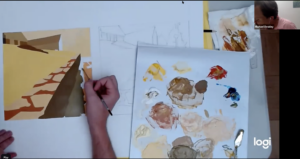
Experimental color compositions: In this project (seen here: Professor Dowley’s demonstration) students use their own photographs of architectural spaces to develop two simplified color compositions. One of the compositions will be monochromatic (one primary color is chosen as a starting color) and the other is developed from complimentary colors.

Paper Cutting: Students learn to cut intricate designs using only paper and x-acto knives. Students develop their images from their own photography and from drawings.(student work: Cornelia Thomas)
ARTS 1600-03 — Design I This is an introductory art studio course. Using drawing, painting, sculpture and photo materials, students learn the principles and elements of design necessary to communicate and express themselves visually. Special topics include collage and papercutting.
This course is taught by Professor Michael Dowley.
ARTS 1600-04 – Design I
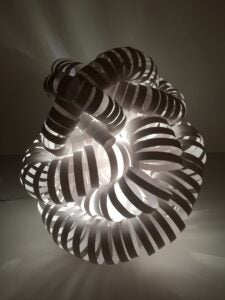
Alexandra Smalto, Paper Luminary Project
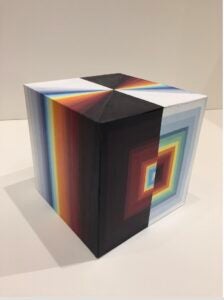
Angela Liu, Color Cube Project

Assignment covering Line and Plane Elements with Repetition and Difference Principles
ARTS 1600-04 – Design I Design I is an introductory art studio course. During the semester, we focus on the study of fundamental skills used for making visual art. This includes both conceptual and technical development. The broad goals of the course are to train our eye to understand and refine compositions as a way to communicate ideas visually. This section of Design will focus on creating three-dimensional forms using easy-to-manipulate materials such as paper, cardboard, foam-board, and wire. This course is required for all art majors and is recommended for art minors and as an elective for students interested in exploring the discipline of studio art.
This course is taught by Professor Evan Reed.
Graphic Design
ARTS 1602-01 — Graphic Design I
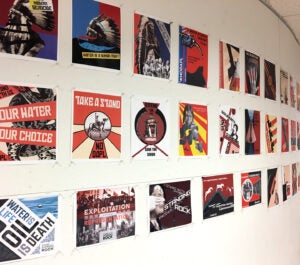
Dakota Access Pipeline protests, also called by the hashtag NoDAPL. Students had studied the bauhaus design and did research on the DAPL and created poster designs.

After learning the tools in illustrator and talking about branding and typography students design a logo, do variations and design business cards for the business and learn about the printing process. Work by Michelle Motta.
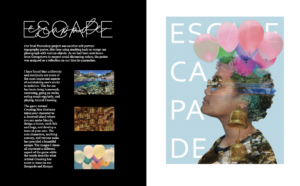
Students learn to do a portfolio newsletter in InDesign for their projects. This a spread from Nia Jordan’s portfolio.
Arts 1602-01 — Graphic Design I: Students will learn the formal, aesthetic, and communicative aspects of creating effective graphic images. Projects include logos, typography, and digital arts that promote mastery of techniques, methods, and materials. In order to foster creativity, we start with breathing meditation at the start of class, followed by discussions about design and learn the Adobe software and the foundation of design principles. The goal of this class is to strengthen students’ visual literacy and communication skills as part of their liberal arts education.
This course is taught by Professor Negar Nahidian.
ARTS 1602-02 – Graphic Design I

Student multilingual print and interactive magazines based on chosen topic, major or minor
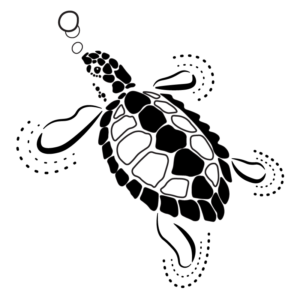
Chiara Lewis, translation drawings, pre-logo

Angela Perez, logo design and branding, laser etched and cut Maker Hub promo item
ARTS 1602-02 — Graphic Design I: This is a studio art class focused on the creation of graphic design assets for print and screen-based media. During this course, you will learn basic Adobe Illustrator, Adobe Photoshop, and Adobe InDesign software through real-world projects and current topics in graphic design. The course seeks to familiarize design students with the communicative power of visual form and to help students develop a personal process of creating original graphic forms capable of effectively communicating a message or information. Projects integrate the following topics: principles of graphic design, design research, logos and branding, album cover design, interactive and print publication design, typography, graphic design history, and professional portfolios.
This course is taught by Professor Toni-Lee Sangastiano.
ARTS 2600-01 — Graphic Design II
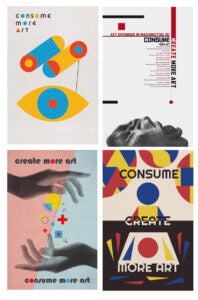
Bauhaus Poster: Consume More Art, Create More Art
After studying the Bauhaus, students were asked to do a poster project based on the Bauhaus principals Design, typography and use of color. Top left: Shana Bottom left: Kate Gregory Bottom right: AndresSiles-Loayza Top right: Edson Martinez
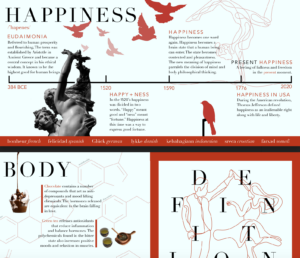
Happiness book:
Students were asked to do the layout and design of a book and send it to print.
They were asked to use Adobe illustrator and photoshop for the images and Adobe Indesign for the layout and typography. Work by Juliette Silvain.
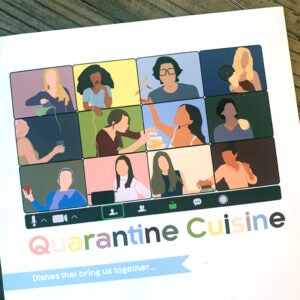
Quarantine Cusine book:
Each student was asked to share their one favorite recipe and to design and do the typography and layout of a spreading he book. Work by Anne-Isabelle de Bokay.
ARTS 2600-01 — Graphic Design II: Students will learn the mindful, formal, aesthetic and communicative aspects of creating effective graphic images. Typography, the history of type, type classifications and more will be taught and discussed. Students will design a book in Indesign and send to print, along with a type classification project cards, and other projects.
This course is taught by Professor Negar Nahidian.
Animation
ARTS 1700-01 — Animation I
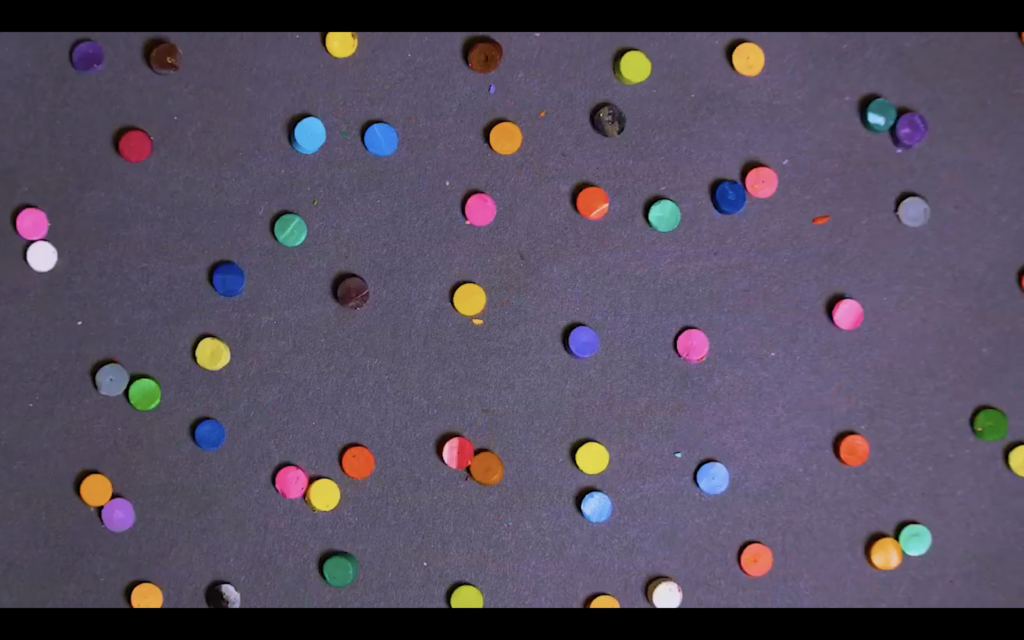
Screengrab from film by student Sarema Shorr
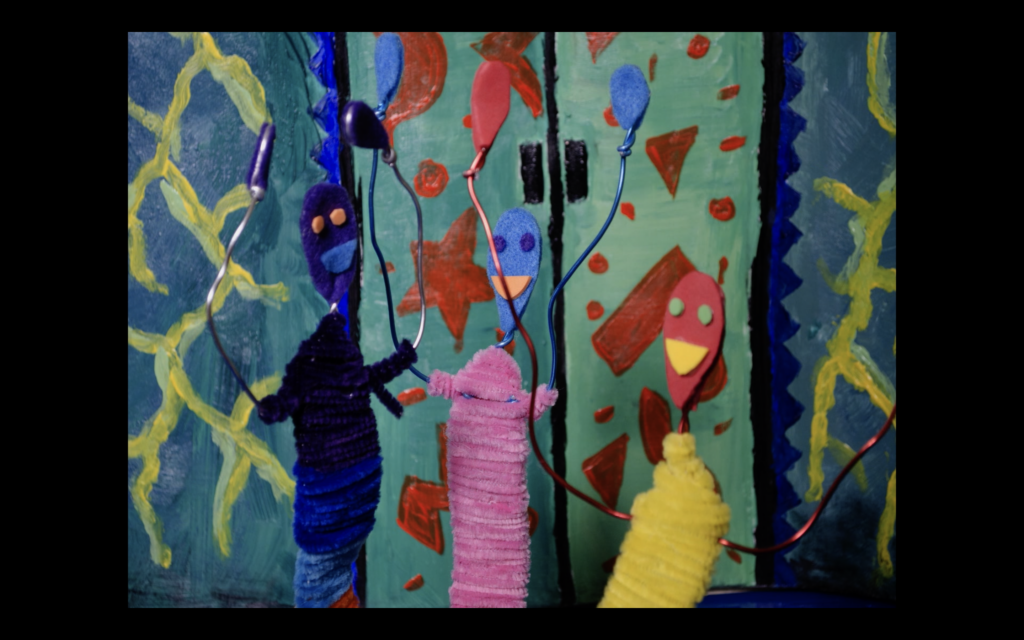
Screengrab from film by student Renata Garcia

Screengrab from film by student Shana Shin
ARTS 1700-01 — Animation I: This course is designed to introduce students to basic methods and practices in animation while exposing them to artists working independently in the field. The course will provide an overview of techniques ranging from hand-drawn frame-by-frame animation, to object animation and pixelation. Each class will consist of a short demonstration, viewing of related works, hands-on experimentation, and critique. Weekly assignments will further students’ exploration of animation approaches and techniques. The course will conclude with the creation of final projects in which students will develop and create an animated short in a medium of their choosing.
This course is taught by Professor Elyse Kelly.
ARTS 2700-01 — Animation II
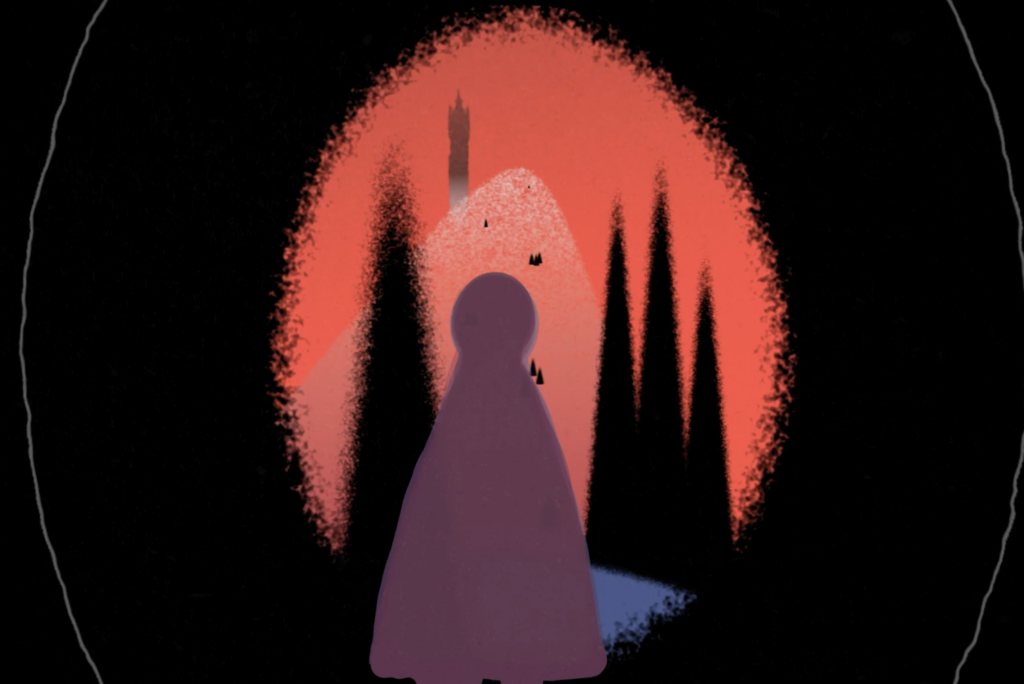
Screengrab from film by student Sarema Shorr
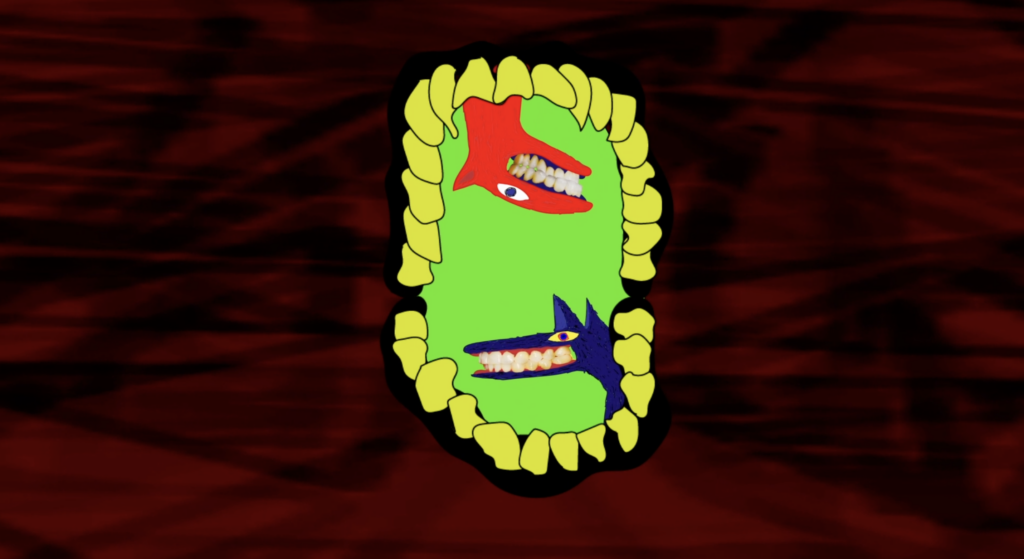
Screengrab from film by student Margaret Neely

Screengrab from film by student Shana Shin
ARTS 2700-01 — Animation II This class is an intermediate course that explores experimental and traditional animation practices through exercises using 2D digital techniques. Each week will consist of a lecture, a screening of related works, and a lab. By the end of this course students will be able to execute short animations, visually express both abstract concepts and conventional narratives, and identify how animation principles affect all animated work be it digital or analog, independent or commercial, refined or rough. Students are expected to play, take risks and work outside their comfort zones.
This course is taught by Professor Elyse Kelly.
Upper Level ARTS Courses
ARTS courses at the 3000-4000 level are designed primarily for Art Majors, Minors and advanced students who want to work with a professor on one or several independent projects over the course of the semester. These courses require approval. Please inquire with the individual instructor for more information.
These courses include:
- ARTS 3200-01 — Printmaking III: Directed Study
- ARTS 3300-01 — Photo III: Directed Study
- ARTS 4302-01 — Photo IV: Directed Study III
- ARTS 4502-01, -02, -03 — Painting IV: Directed Study III
Art History Courses
ARTH 1120-01 — Buddhist Art
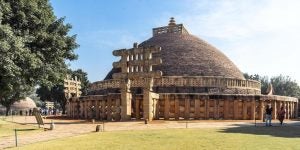
Great Stupa at Sanchi, 3rd century BCE-1st century CE, Madhya Pradesh, India
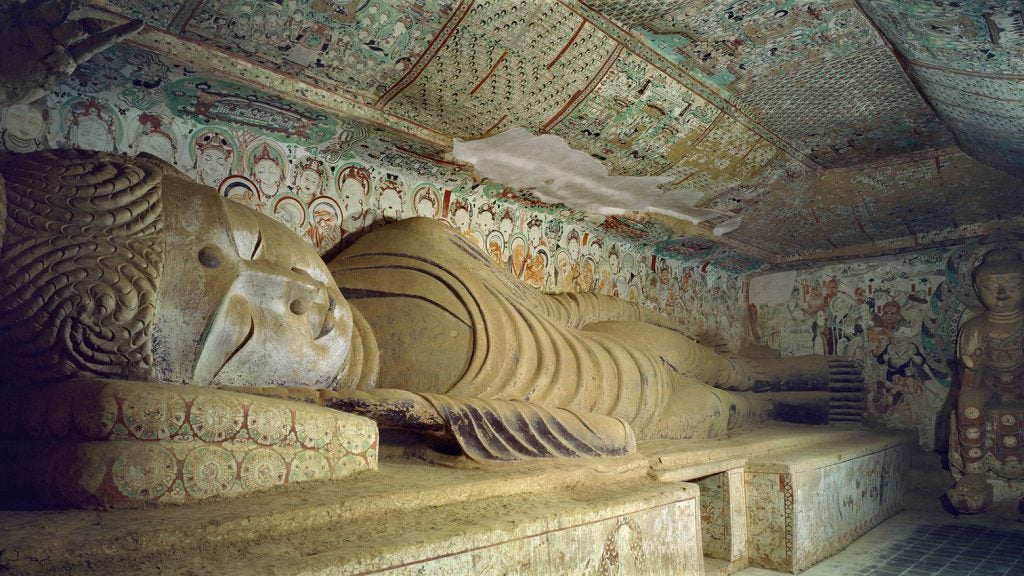
Buddha in Parinirvana, Mogao Cave 158, Tang Dynasty (618-907), Dunhuang, Gansu Province, China

Hakuin Ekaku, “Two Blind Men Crossing a Log Bridge,” Edo Period (1615-1868), hanging scroll, ink on paper, Manyo’an Collection
ARTH 1120-01 — Buddhist Art This course will survey the Buddhist art and architecture of Asia through selected case studies of artworks and sites in South Asia, Southeast Asia, and East Asia. Among the topics to be studied include: representations of the historical Buddha’s life, rock-cut architecture, monastic complexes, painted mandalas, Zen portraits, as well as the roles played by patronage, pilgrimage, and ritual. Our focus upon the Buddhist art and architecture of Asia will allow us to think through not only the historical development of the religion and its visual and architectural forms, but also issues of cross-cultural transmission. In the process, students will gain familiarity not only with the religious and historical context of the artworks and sites and with the basic iconography of Buddhist deities, but also with methods of visual analysis that form the basis of art historical methodology. No prior knowledge of Asian art or religions is required or assumed.
This course is taught by Professor Michelle Wang.
ARTH 1640-01 — Renaissance to Modern Art
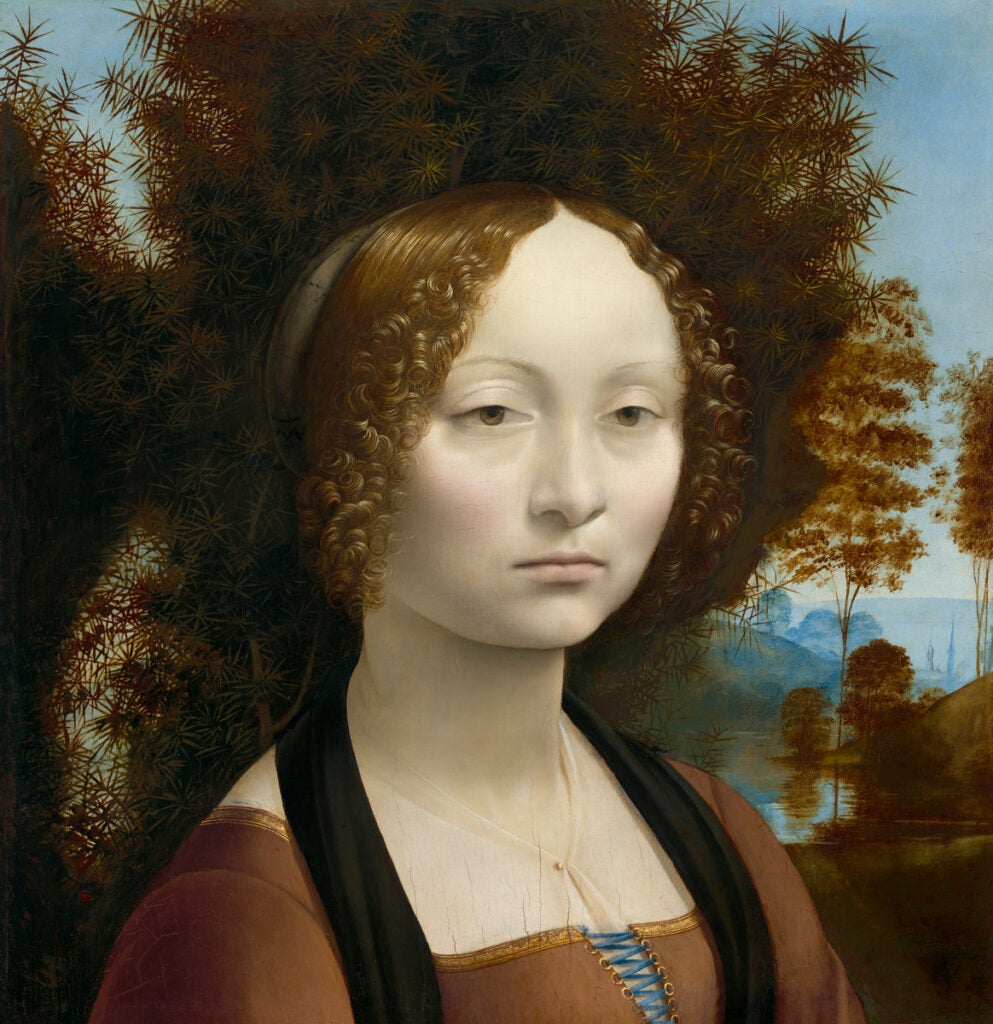
Leonardo da Vinci, Ginevra de’Benci, 1474/78

Edouard Manet, Lunch on the Grass, 1863
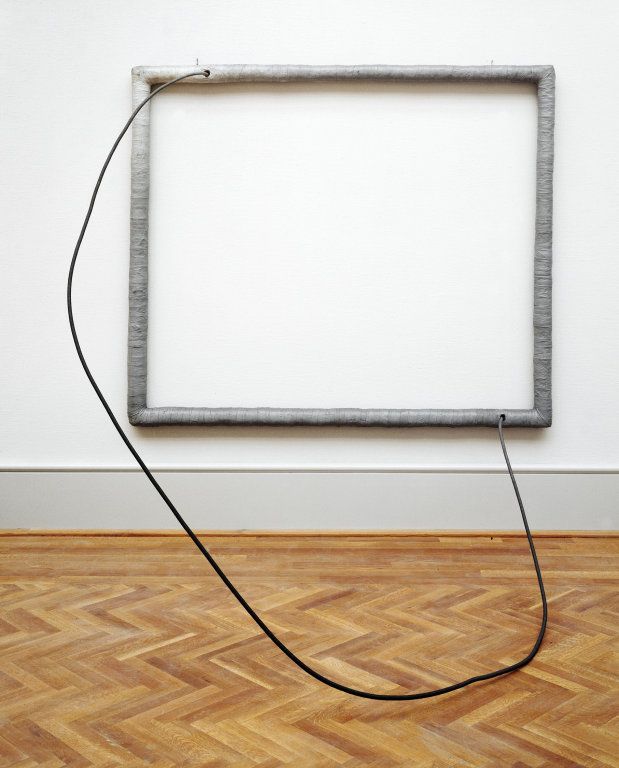
Eva Hesse, Hang Up, 1966
ARTH 1640-01 — Renaissance to Modern Art This course surveys over six centuries of art to serve as an introduction to the history of Western culture, aesthetics, and civilization. During the semester, we will consider the work of major artists and artistic movements in the history of art from the beginning of the Italian Renaissance through the Modern era. The emphasis is on painting, sculpture, and architecture. The interaction of art and society will be explored through the chronological presentation of historical periods, permitting us to study the transformation of style and taste in relation to the changing culture and history of a particular time. The aim of the course is to provide a coherent framework for understanding the history of art in Europe and North America after 1300.
This course is taught by Professor Barrett Tilney.
ARTH 1760-01 — GU: Architecture & History

Smithmeyer & Co. Southview of Georgetown College. Ink with watercolor on paper. 1875
Source: Georgetown University Art Collection, Lauinger Library, Booth Family Center for Special Collections, Washington, D.C. 1111.1.959
ARTH 1760-01 — GU: Architecture & History This course will provide an in-depth look into Georgetown University’s architectural development over time. Beginning in the eighteenth century and moving to contemporary campus developments, students will explore iconic buildings and landscape changes. Among the many structures we will investigate are Dahlgren Chapel, Healy Hall, Isaac Hawkins Hall, the Car Barn, Observatory and Lauinger Library. Structures will be studied within their cultural context with issues relating to the country’s broader political environment, university leadership and slavery playing a role in our study. We will also note various unrealized campus building plans. Wider developments in American university architecture will be discussed. This course will provide students with outstanding practical research experience as our work will parallel the development of a Georgetown campus guidebook. This course requires no prior knowledge of architectural history and will introduce students to general building styles via university examples.
This course is taught by Professor Stephanie Rufino.
ARTH 1910-01 — What is contemporary art?
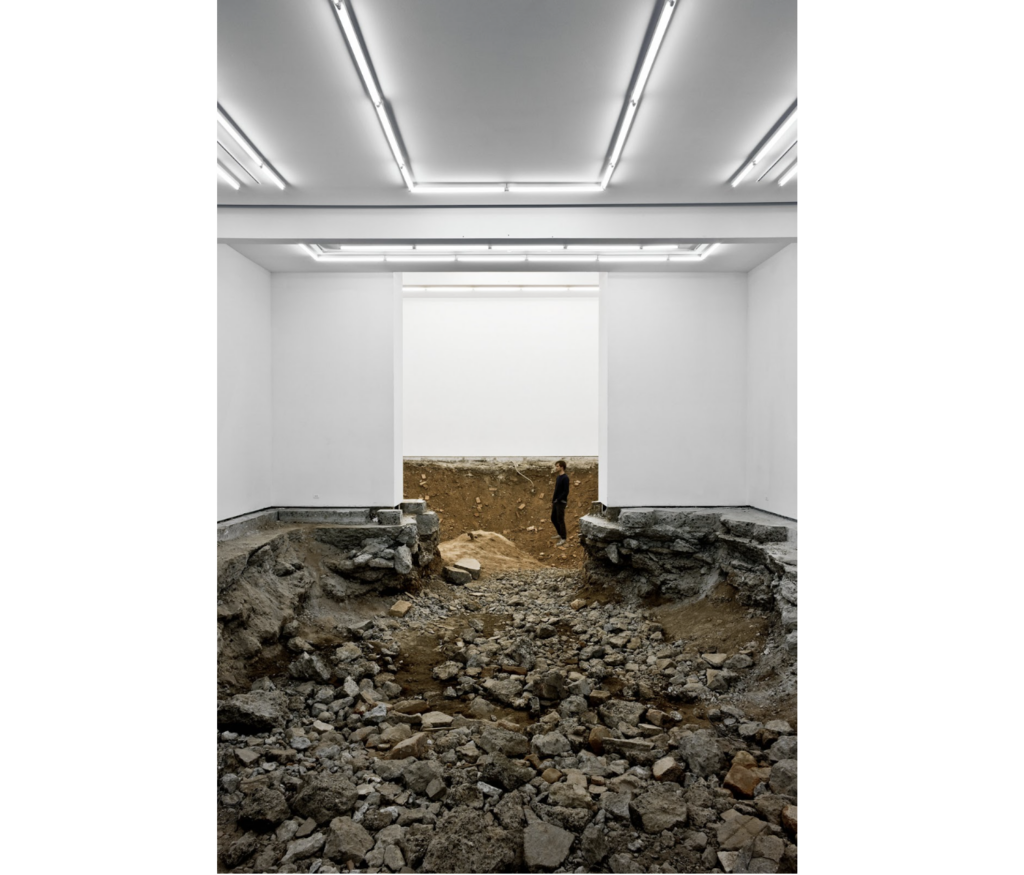
Urs Fischer, “You”, 2007, excavation of Gavin Brown Enterprise gallery space
ARTH 1910-01 — What is contemporary art?: This class will explore what makes art “contemporary” and how, when, and why that determination is made. Through readings and group discussions, we will analyze historical moments when artists, writers, scholars, and the art market shifted the boundaries and definition of contemporary art. The goal of the class is to empower students to understand how contemporary art has been defined in the past and to bolster their agency in affecting how contemporary art is defined in the future.
This course is taught by Professor Vlad Smolkin.
ARTH 2140-01 — History of Prints

Rembrandt, Self-Portrait, 1630; Goya, The Sleep of Reason Produces Monsters, 1799; Jasper Johns, Untitled, 1977.
ARTH 2140-01 — History of Prints This course surveys the history of prints (mainly reproducible images on paper) in Europe and the United States c. 1400-present. Although they are sometimes treated as a secondary art, prints were absolutely central to the development of post-medieval western art and society. As relatively inexpensive, multiplied objects, they fundamentally reshaped ideas about what images could look like, mean, and accomplish. Prints played an immeasurable role in the development and spread of new visual ideas, an international art market, propaganda, social commentary, and much more.
The course combines two main approaches: 1) the distinctive history of printmaking, including origins, evolution of techniques, and the political, religious, and cultural functions of prints; and 2) individual artistic developments with emphasis on the work of influential printmakers, changing iconography, and formal innovations. Among major artists to be addressed in some depth are Dürer, Rembrandt, Goya, and Johns. We will make use of the extraordinary abundance of prints in Washington collections, including two visits to the National Gallery of Art.
This course is taught by Professor Alfred Acres.
ARTH 2441-01 — Medieval Sicily
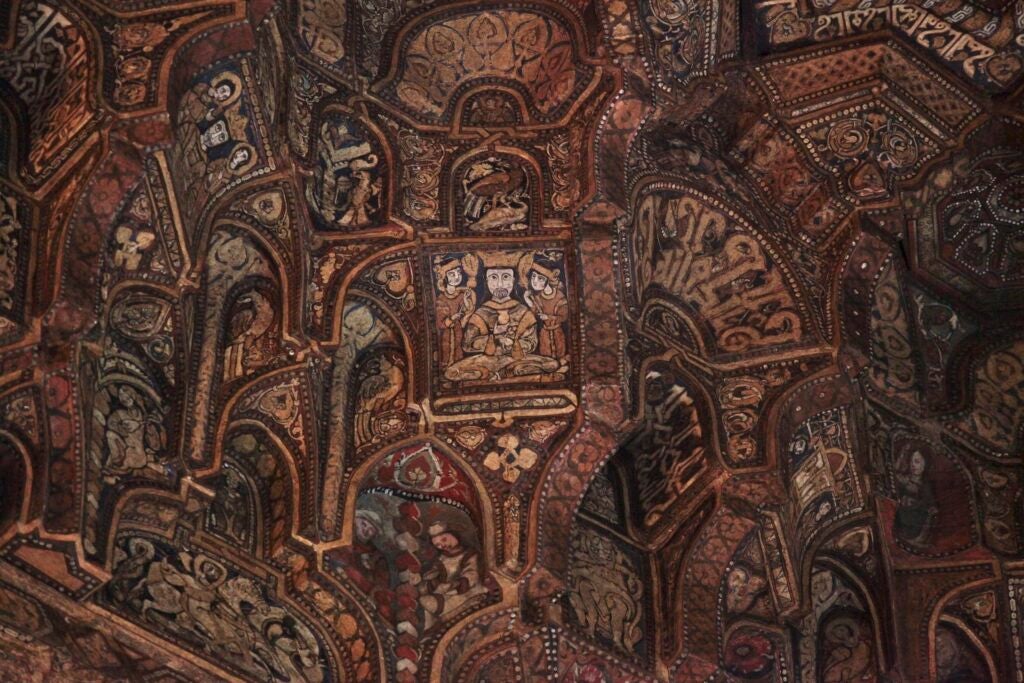
Detail of muqarnas ceiling, Cappella Palatina, c. 1130–43, Palermo (photo: Ariel Fein, CC BY-NC-SA 2.0)
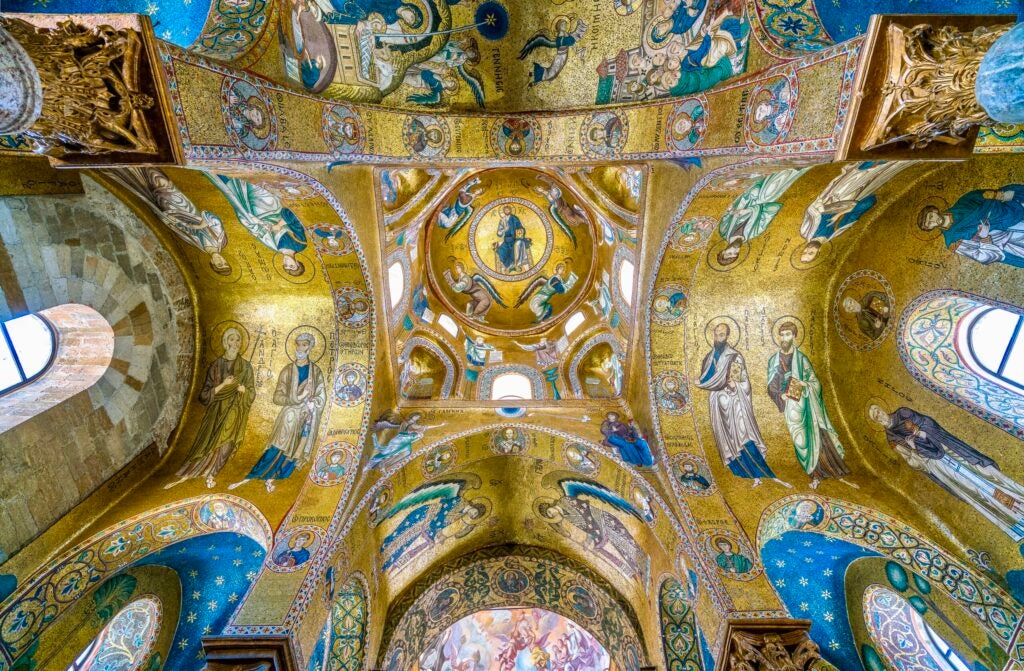
Mosaics in the dome and nave (1140-1155 CE), Santa Maria dell’Ammiraglio (La Martorana), Palermo.

Benedictine Cloister built by William the Good (1174-76), Monreale Cathedral, Palermo.
ARTH 2441-01 — Medieval Sicily Pilgrims, immigrants, saints, administrators, and knights made their way to the shores of Sicily, constantly transforming the cultural and social fabric of the island throughout the medieval period. This course begins with Emperor Justinian’s reconquest of Sicily from the Ostrogoths in 535 CE, tracing the complexity of the Muslim invasion in 827 CE, to the Norman reign from 999 – 1130 CE, ending with the Angevin dynasty’s shaky hold in 1266 and its deliverance to the House of Aragon in 1282. We will examine the overlapping influences of Greek, Latin, Roman, German, Muslim, Jewish, Norman, Angevin (France & England) and Aragon (Spain) cultures in the production of painting, architecture, sculpture, illuminated manuscripts, textiles, and jewelry. Students will learn how Byzantine, Islamic, Gothic, and Romanesque art styles converged in this unique territory where soldiers, kings, caliphs, and popes wrestled to gain and keep control of “the island of fertility.”.
This course is taught by Professor Tiffany Hunt.
ARTH 2642–01 — Dutch Art/Age of Rembrandt
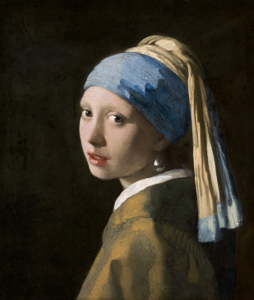
Johannes Vermeer, “The Girl with a Pearl Earring,” c. 1665 (Mauritshuis, The Hague)

Rembrandt van Rijn, “The Nightwatch,” 1642 (Rijksmuseum, Amsterdam)
ARTH 2642–01 — Dutch Art/Age of Rembrandt You have most likely heard of Johannes Vermeer and Rembrandt van Rijn whose paintings have been the focus of countless exhibitions, films, and novels. While we will study their careers and remarkable artworks in-depth, their paintings comprise only a tiny fraction of an estimated 5-10 million works of art produced in the 17th-century Dutch Republic (now the Netherlands) for a population of about the same as Philadelphia today. One scholar estimates that, at times, artists made up 5% of the male labor force in dutch towns. Our class will explore this explosion of art. In addition to surveying other artists and their paintings and prints, we will consider the broader context of the profusion of art: political independence, trade, and exploration, a unique art market, a wide range of buyers, and new methods of production.
This course is taught by Professor Barrett Tilney.
ARTH 3840-01 — Radical Art Russia/East Europe
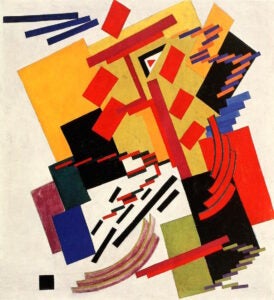
Olga Rozanova, Non-Objective Composition. Suprematism (1916)
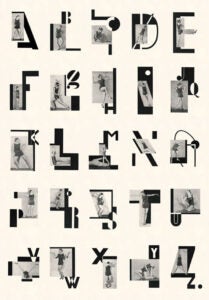
Karel Teige et al., typophotomontage from ABCs (1926)
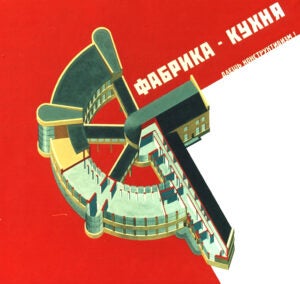
Ekaterina Maksimova (architect) et al, Factory Kitchen (1931)
ARTH 3840-01 — Radical Art Russia/East Europe This course investigates the experimental art of Russia and Eastern Europe in the first decades of the 20th century in a comparative context. Our aim is to examine the commonalities among the diverse radical groups that identified themselves with “the avant-garde,” to consider how avant-garde artists defined their place in society and negotiated their relationship to politics, and to reflect on the position of experimental artists from this geographic region within broader European trends. We ask: what distinguishes the avant-garde from other modernist trends? Can we speak of a unified international movement known as “the avant-garde,” or are there many avant-gardes? What is the relationship of the avant-garde to nationalism, cosmopolitanism, and internationalism? Where does the avant-garde stand in relation to socialist revolution and leftist politics? We consider these and other questions by interrogating the avant-garde’s relationship to the past, history, and tradition, and by examining the techniques, media, and genres that were pervasive throughout its different factions. The media include: painting, poetry, artist’s books, performance, photomontage, film, architecture. Movements covered: Futurism, Dadaism, Constructivism, Surrealism & others. For the final students have the option to pursue a creative project that engages avant-garde techniques and strategies studied in the course.
This course is taught by Professor Irina Denischenko.
ARTH 3910–01 — How Art Moves
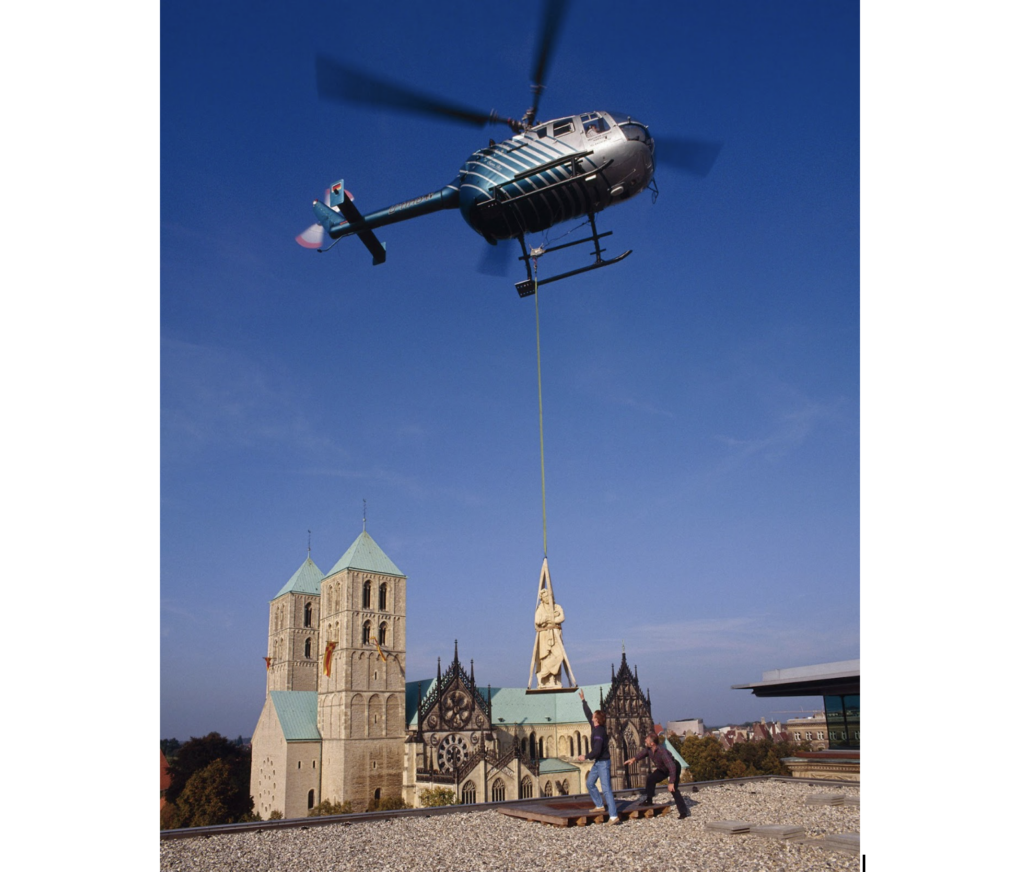
Ayşe Erkmen, “Sculptures on air,” (1997) Skulptur Projekte Münster. Photography by Roman Mensing.
ARTH 3910–01 — How Art Moves How do artworks move through the world? This class will incorporate readings and case studies to explore how art moves—from the artist’s mind, to the creative act of making, to exhibitions at galleries, sales to collectors, display at art fairs, inclusion in art auctions, and entry into museum permanent collections. This class will trace the provenance and journey of a variety of artworks, exploring the effect of cultural, political, and economic factors on art’s geographic migrations and contextual meanings.
This course is taught by Professor Vlad Smolkin.
ARTH 4123 — Archaeology in China
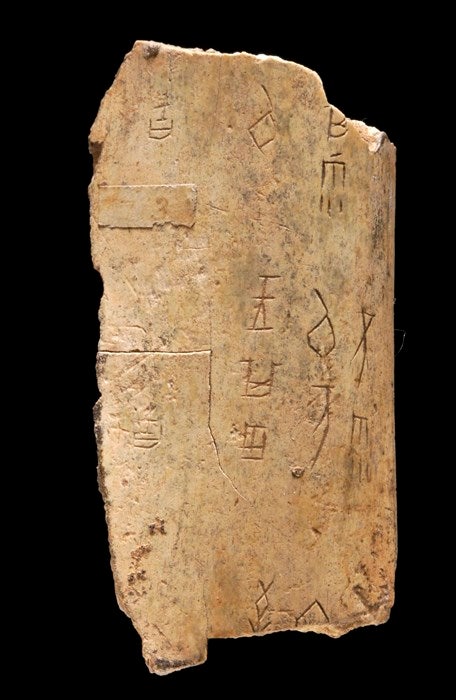
Oracle bone made of tortoise plastron with incised script recording divination, late Shang dynasty (1250 BCE-ca. 1050 BCE). Excavated near Anyang, Henan Province, China. National Museums Scotland.

Animal-shaped bronze ritual vessels, late Shang dynasty (1250 BCE-ca. 1050 BCE). National Museum of Asian Art.
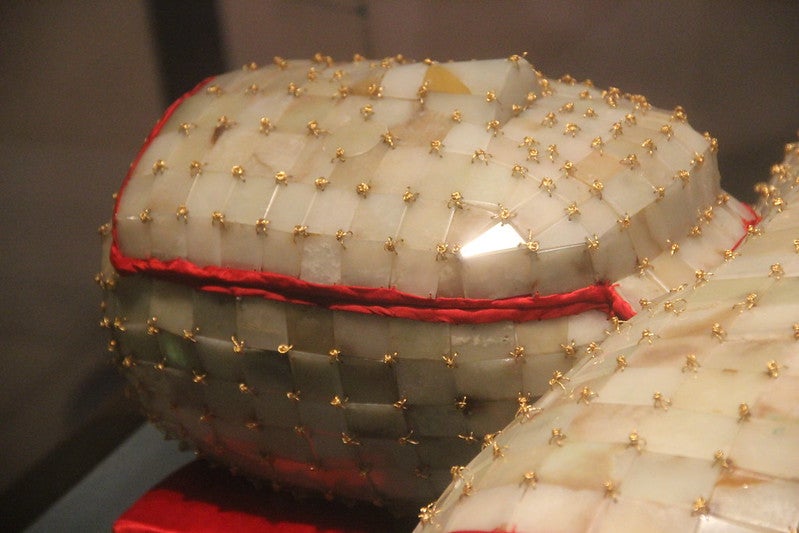
Life-sized jade burial suit with gold thread, Western Han dynasty (206 BCE-9 CE). Excavated from the tomb of the King of Chu at Shizishan, Xuzhou, Jiangsu Province, China in 1995. Xuzhou Museum.
ARTH 4123 — Archaeology in China From the “dragon bones” unearthed by farmers in the late 19th century to tombs uncovered during road-building projects today, archaeological discoveries continue to augment and rewrite our knowledge of Chinese history, art, religion, and society. This seminar will examine major archaeological sites in China from the Neolithic period (ca. 7000-1700 BCE) to the Tang dynasty (618-907 CE) and analyze the insights that they offer into Chinese religion and cosmology, the conceptualization of death and the afterlife, premodern technologies and art-making techniques, and more. Each week, we will focus on a specific site as well as key figures and institutions in the rise of scientific archaeology in 20th century China. Moreover, we will pay special attention to the ongoing dialogue between archaeology and narratives of national and regional identity, and issues of cultural heritage protection.
This course is taught by Professor Michelle Wang.
ARTH 4650-01 — Race & Color in Latin America

ARTH 4650-01 — Race & Color in Latin America The seminar examines the history of portraiture and casta paintings in Latin America from the late sixteenth through the early nineteenth century. The course primarily focuses on casta paintings—a unique pictorial genre that appropriated as its subject the issue of race and miscegenation. By studying casta paintings and portraits commissioned by the Spanish elite, the seminar analyses the pivotal role that art played in maintaining and exacerbating inequalities based on color, race, gender, and ethnicity. During Viceregal times, concepts of ethnicity, race, and identity were fundamental elements of social stratification based on physical characteristics, sumptuary rules, and statutory and customary laws that decreed the place of an individual in a certain casta based exclusively on the Spanish statute of limpieza de sangre (“purity of blood”). Placing particular emphasis on historical, social, cultural, economic, and political aspects, the course introduces students to major theoretical concepts of belonging, inclusion, and exclusion. Moreover, the seminar aims to understand the construction of racial identity in the viceroyalties and challenge the intersection of art, race, gender, and class in Latin America.
This course is taught by Professor Andrea Gallelli Huezo.
ARTH 4762-01 — The American Landscape

Thomas Cole, View of the Round-Top in the Catskill Mountains, 1827, MFA Boston
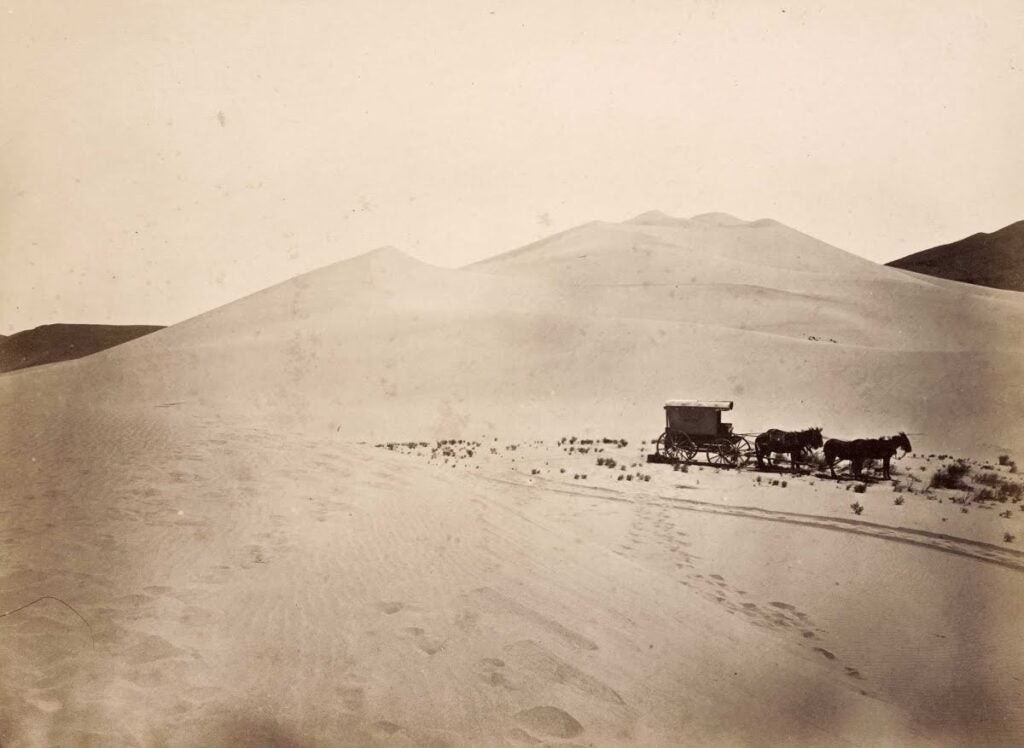
Timothy H. O’Sullivan Sand Dunes, Carson Desert, Nevada, 1867 Albumen print from wet collodion negative, Cleveland Museum of Art
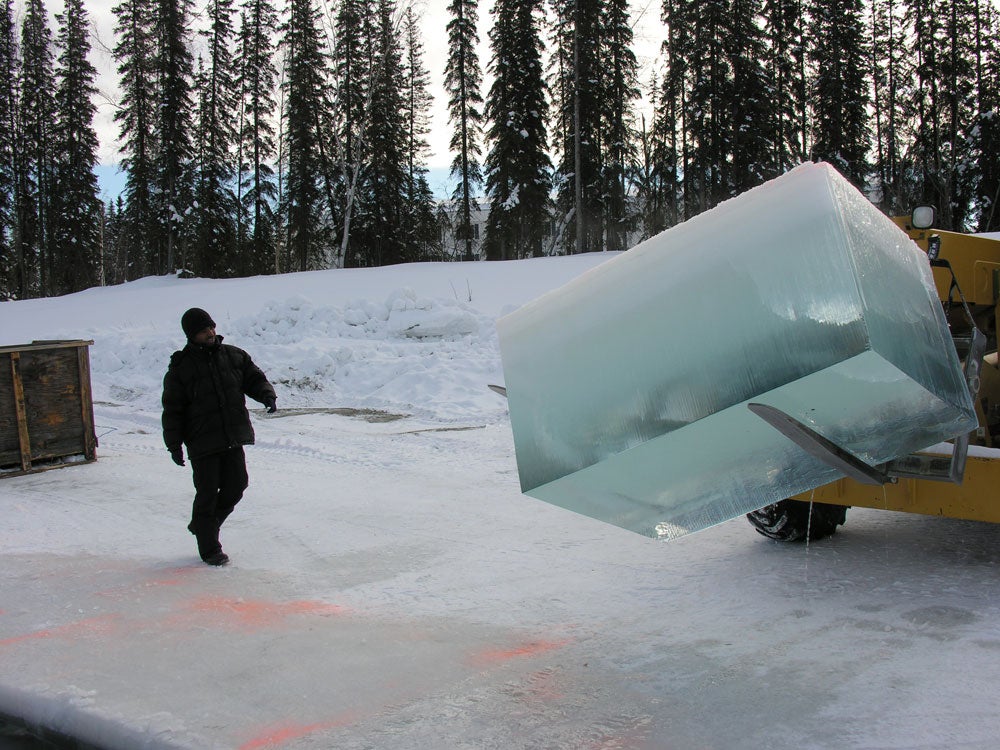
Tavares Strachan constructing The Distance Between What We Have and What We Want, 2005, Marian Goodman Gallery
ARTH 4762-01 — The American Landscape For over two-hundred years, American artists have used painting, prints, photography, and conceptual art to explore the relationship between humans and the environment. This course will examine aesthetic and cultural themes in American landscape from 1800 to the present, including the sublime, the picturesque, industrialism, nostalgia, Westward expansion, colonialism, the ‘end’ of landscape, environmentalism, abstraction, and conceptualism. The course will meet in the Barbara Ellis Jones Classroom in the Booth Family Center for Special Collections where we will look at landscapes in Georgetown’s art and rare book collections.
This course is taught by Professor Lisa Strong.
ARTH 4841-01 — Expressionism & Weimar Culture
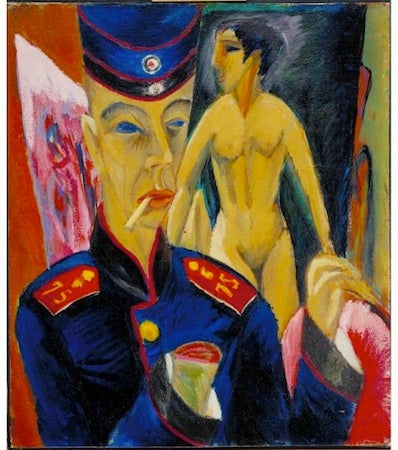
Ernst Ludwig Kirchner, Self-Portrait as a Soldier, 1915, oil on canvas, 69 x 61 cm (Allen Memorial Art Museum, Oberlin College).
ARTH 4841-01 — Expressionism & Weimar Culture Most everyone knows what was going on in the world of French art in the first half of the 20th century – Fauvism, Cubism, and so forth. But during the same period, German artists created a convention-shattering movement called Expressionism, which informed every aspect of the cultural life of the country. This seminar explores the new trend through the work of the two groups Die Brücke (The Bridge) and Der blaue Reiter (The Blue Rider) that came to represent the avant-garde of the time, as well as contemporary architecture, film, and drama. We will then concentrate on exploring the daring, politicized milieu of the post-WWI Weimar Republic (1919-1933), looking at the Bauhaus collective, the Dadaists, and the fascist realism of the Nazi party. The seminar concludes with the terrifying landmark of the 1937 “Degenerate Art” exhibition. There will be a museum field trip to study Expressionist paintings and prints.
This course is taught by Professor Elizabeth Prelinger.
ARTH 4950-01 — Museum Fieldwork: Directed Study
ARTH 4950-01 — Museum Fieldwork: Directed Study Students must have 9 credits in Art History and the advisor’s approval required. Only art history Junior and Senior majors or minor students.
This course is taught by Professor Elizabeth Prelinger.
ARTH 4998-01, -02 — Senior Thesis
ARTH 4998, Senior Thesis: By arrangement with a faculty adviser, majors may write a senior thesis on an art historical topic of their choosing. The thesis is optional but can serve as a capstone course that prepares students for future professional or graduate work.
This course is taught by Professor Elizabeth Prelinger and Professor Lisa Strong.
Art & Museum Studies Courses
AMUS 5209-01 — Climate Action in Museums

The Secretary of The InterIor’s Standards for Rehabilitation & Illustrated Guidelines on Sustainability for Rehabilitating Historic Buildings, 2011. A green roof on the top of the Department of the Interior, Washington, DC.
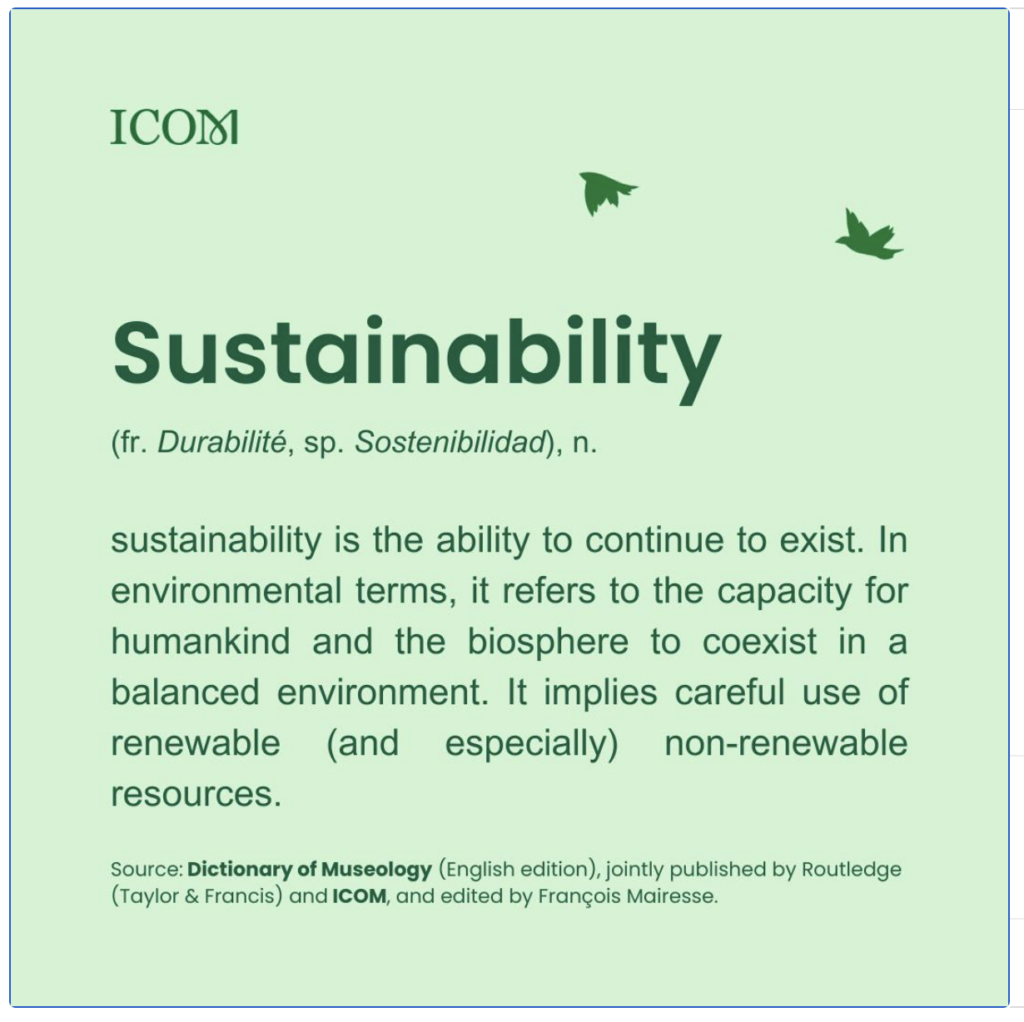
The International Council of Museums definition of Sustainability from the Dictionary of Museology, 2023.

The Climate Museum in New York City operates without a permanent brick and mortar location. It brings the message of climate action to locations around the city through “a series of transit-accessible exhibitions and pop-ups”.
AMUS 5209-01 — Climate Action in Museums Seen as some of the most trusted institutions in American public life, museums are uniquely positioned to facilitate public discussion of the environment and climate change with an opportunity to protect and strengthen these institutions. Surveying the evolution of sustainability in museums over the last fifteen years, this course examines the practical aspects of collections care, interpretation and public programming, operational changes, building construction, and community engagement to examine how changes in museum work can deepen museums’ connections to their communities and increase their charitable value. Students discuss and share ideas frequently in class, developing graded projects with feedback from classmates and the instructor. Topics include human behavior (the challenge of change, in daily practice or major projects, and how museums are well-suited to support staff, visitors, and communities in making change); mitigation (why/how museums and communities are reducing their negative effects on the environment, the climate, and to social and financial stability); and resilience (why and how museums are creatively helping their communities become more environmentally, financially, and socially adaptable in the face of a changing climate and increased impacts from weather events; how museums can share with the public the scientific and social discoveries enabling widespread change).
This course is taught by Professor Jerry Foust.
AMUS 5210-01 — Museum Development

Fundraising Elements

Types of Fundraising
AMUS 5210-01 — Museum Development This course will focus on demystifying fundraising in a museum environment. We will cover the fundamentals of fundraising including building a case for support, moving a donor or potential donor from engagement to giving, making the ask for support, and stewarding donors. Additionally, we will examine the varied fundraising needs in museums, categories of donors that give to museums, diverse motivations for giving, and fundraising ethics. The course will feature projects, readings, and guest lectures that address how to effectively pitch fundraising projects, collaborate with other museum departments, and build long-term support for key initiatives.
This course is taught by Professor Nia Davis.
AMUS 7952-01 — Spring Internship
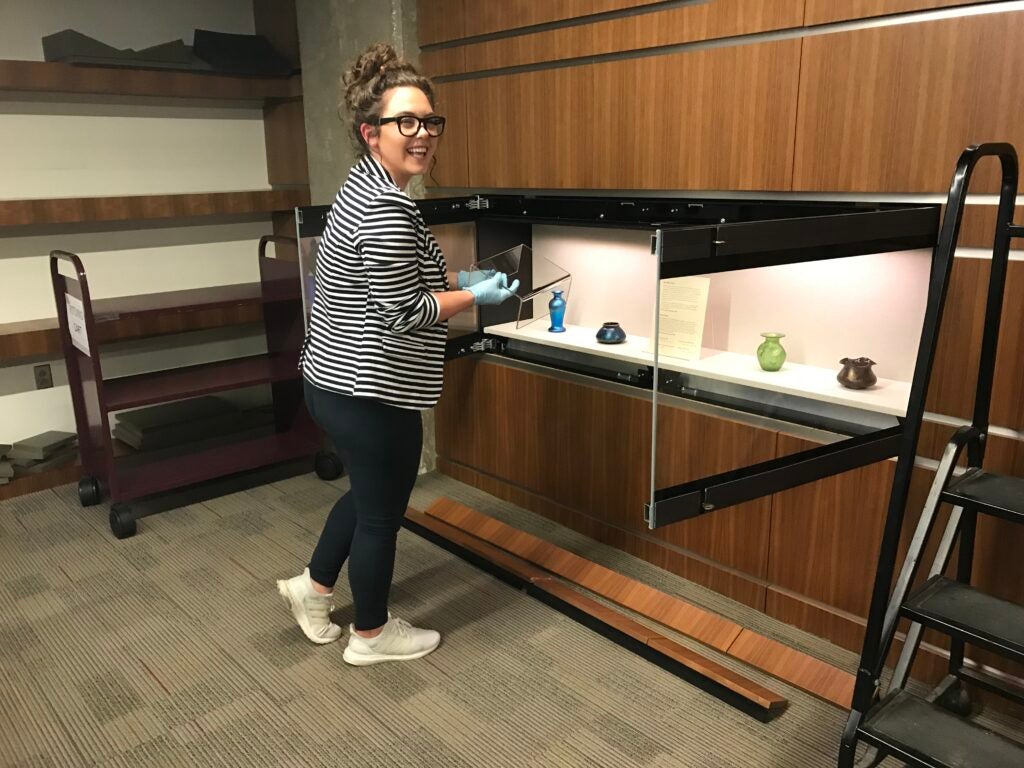
An Art and Museum Studies student installs her exhibition at Booth Family Special Collections, Georgetown University
AMUS 7952-01 — Spring Internship Museum internships provide concentrated practical experience within selected museum departments as well as an overview of the operations of a museum. Some of our internships include a staff-directed seminar; most involve a linked research project as well as an internship journal. Expectations and placement will be discussed during the orientation session. Schedule determined by student and museum supervisor; 15–20 hours/wk. Art and Museum Studies students only.
This course is taught by Professor Lisa Strong.